Mitsubishi Electronics F7500, 164, EYS User Manual

IMMERSIVE SOUND LED LCD HDTV
with Integrated Sound Projector
MODELS
154 Series
164 Series
265 Series
OWNER’S GUIDE
•For questions:
-- Visit our website at www.mitsubishi-tv.com. -- E-mail us at MDEAservice@mdea.com.
-- Call Consumer Relations at 800-332-2119 for operational or connection assistance.
•For information on System Reset, please see the back cover.
•To order replacement or additional remote controls, visit our website at www.mitsuparts.com or call 800-553-7278.
•265 Series. IR emitter cables for NetCommand home-theater control are available for purchase from Mitsubishi. Call 800-553-7278 and request either part number 242D483020 (two-ended cable) or part number 299P254020 (four-ended cable).
®
Downloaded From TV-Manual.com Manuals
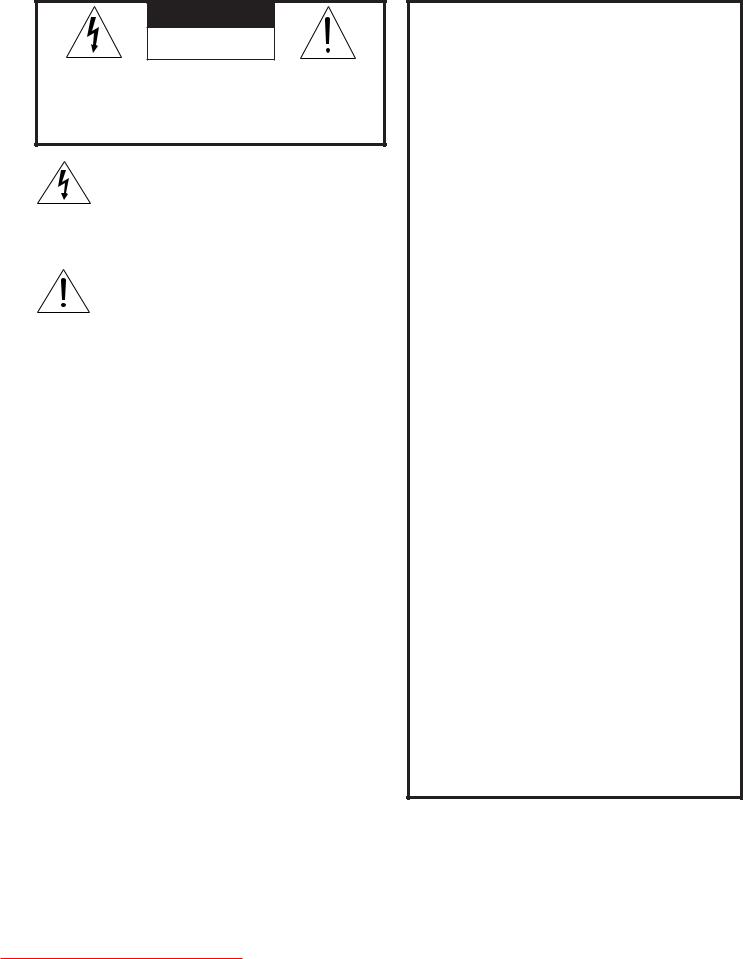
CAUTION
RISK OF ELECTRIC SHOCK
DO NOT OPEN
CAUTION: TO REDUCE THE RISK OF ELECTRIC SHOCK, DO NOT REMOVE COVER (OR BACK). NO USER SERVICEABLE PARTS INSIDE. REFER SERVICING TO QUALIFIED SERVICE PERSONNEL.
The lightning flash with arrowhead symbol within an equilateral triangle is intended to alert the user of the presence of uninsulated “dangerous voltage” within the product’s
enclosure that may be of sufficient magnitude to constitute a risk of electric shock to persons.
The exclamation point within an equilateral triangle is intended to alert the user to the presence of important operating and maintenance (servicing) instructions in the literature accompanying the product.
WARNING: This product shall be connected to a MAINS socket outlet with a protective earthing connection.
MAINS DISCONNECTION: The mains plug is used as the disconnect device. The mains plug shall remain readily operable.
WARNING: To reduce the risk of fire or electric shock, do not expose this apparatus to rain or moisture.
This apparatus shall not be exposed to dripping or splashing and no objects filled with liquids, such as vases, shall be placed on the apparatus.
WARNING: This product contains chemicals known to the State of California to cause cancer and/or birth defects or other reproductive harm.
TV WEIGHT: This TV is heavy. Exercise extreme care when lifting or moving it. Lift or move the TV with a minimum of two adults. To prevent damage to the TV, avoid jarring or moving it while it is turned on. Always power off your TV, unplug the power cord, and disconnect all cables before moving it.
Note: Features and specifications described in this owner’s guide are subject to change without notice.
DownloadedFor assistanceFrom TV-Manualcall.com 1(800)Manuals 332-2119
FCC Declaration of Conformity
Product: |
LCD Flat Panel HDTV |
Models: |
LT-55154 |
|
LT-40164, LT-46164, LT-55164 |
|
LT-46265, LT-55265 |
Responsible |
Mitsubishi Digital Electronics |
Party: |
America, Inc. |
|
9351 Jeronimo Road |
|
Irvine, CA 92618-1904 |
Telephone: |
(800) 332-2119 |
This device complies with Part 15 of the FCC Rules. Operation is subject to the following two conditions:
(1)This device may not cause harmful interference, and
(2)This device must accept any interference received, including interference that may cause undesired operation.
Note: This equipment has been tested and found to comply with the limits for a Class B digital device, pursuant to part 15 of the FCC Rules. These limits are designed to provide reasonable protection against harmful interference in a residential installation. This equipment generates, uses and can radiate radio frequency energy and, if not installed and used in accordance with the instructions, may cause harmful interference to radio communications. However, there is no guarantee that interference will not occur in a particular installation. If this equipment does cause harmful interference to radio or television reception, which can be determined by turning the equipment off and on, the user is encouraged to try to correct the interference by one or more of the following measures:
-Reorient or relocate the receiving antenna.
-Increase the separation between the equipment and the receiver.
-Connect the equipment into an outlet on a circuit different from that to which the receiver is connected.
-Consult the dealer or an experienced radio/TV technician for help.
Changes or modifications not expressly approved by Mitsubishi could cause harmful interference and would void the user’s authority to operate this equipment.

Contents
Important Information About Your TV
Installation and Operating Notes. . . . . . . . . . . . . . 4
Important Safety Instructions. . . . . . . . . . . . . . . . 5
Stand Installation.. . . . . . . . . . . . . . . . . . . . . . . . . 6
Wall-Mounting. . . . . . . . . . . . . . . . . . . . . . . . . . . . |
7 |
|
1 |
Basic Setup and Operation |
|
|
Package Contents. . . . . . . . . . . . . . . . . . . . . . . . |
9 |
|
Before You Begin.. . . . . . . . . . . . . . . . . . . . . . . |
10 |
|
First-Time Power-On.. . . . . . . . . . . . . . . . . . . . . |
10 |
|
TV Controls.. . . . . . . . . . . . . . . . . . . . . . . . . . . |
11 |
|
Remote Control. . . . . . . . . . . . . . . . . . . . . . |
11 |
|
The TOOLS Key and Menu. . . . . . . . . . . . . . |
12 |
|
TV Control Panel. . . . . . . . . . . . . . . . . . . . . |
13 |
|
POWER Indicator. . . . . . . . . . . . . . . . . . . . . |
13 |
|
Setting Up TV Inputs. . . . . . . . . . . . . . . . . . . . . |
14 |
|
Basic TV Operation. . . . . . . . . . . . . . . . . . . . . . |
16 |
|
Using the TV with a Personal Computer. . . . . . . . |
19 |
2 |
TV Connections |
|
|
Before You Begin.. . . . . . . . . . . . . . . . . . . . . . . |
21 |
|
Connection Types and Audio/Video Quality .. . . . |
21 |
|
Inputs and Outputs. . . . . . . . . . . . . . . . . . . . . . |
22 |
|
Cable Routing. . . . . . . . . . . . . . . . . . . . . . . . . . |
22 |
|
HDMI Device.. . . . . . . . . . . . . . . . . . . . . . . . . . . . . |
24 |
|
Y Pb Pr Component Video Device. . . . . . . . . . . . |
25 |
|
DVI Video Device. . . . . . . . . . . . . . . . . . . . . . . . |
25 |
|
Antenna or Cable TV Service.. . . . . . . . . . . . . . . |
26 |
|
Composite Video Device.. . . . . . . . . . . . . . . . . . |
26 |
|
VCR or DVD Recorder to an Antenna or |
|
|
Wall Outlet Cable. . . . . . . . . . . . . . . . . . . . . . . |
26 |
|
A/V Receiver. . . . . . . . . . . . . . . . . . . . . . . . . . . |
27 |
|
A/V Receiver with HDMI Output.. . . . . . . . . . . . . |
27 |
|
Supplemental Audio Connections . . . . . . . . . . |
28 |
3 |
TV Features |
|
|
Sleep Timer.. . . . . . . . . . . . . . . . . . . . . . . . . . . |
29 |
|
FAV (Favorite Channels). . . . . . . . . . . . . . . . . . . |
29 |
|
ChannelView Channel Listings.. . . . . . . . . . . . . . |
30 |
|
Status Display. . . . . . . . . . . . . . . . . . . . . . . . . . |
31 |
|
Using an External Sound System.. . . . . . . . . . . . |
32 |
|
Picture Shape and Display Formats. . . . . . . . . . . |
33 |
|
Camera Images and Music Files. . . . . . . . . . . . . |
34 |
|
USB Source Devices. . . . . . . . . . . . . . . . . . |
34 |
|
Photos and Motion Video as |
|
|
Composite Video. . . . . . . . . . . . . . . . . . . . |
36 |
|
Using an Audio-Only Device. . . . . . . . . . . . . |
36 |
|
Wireless Audio Playback.. . . . . . . . . . . . . . . |
37 |
Downloaded From TV-Manual.com Manuals |
|
|
Sound Projector.. . . . . . . . . . . . . . . . . . . . . . . . |
38 |
StreamTV™ Internet Media.. . . . . . . . . . . . . . . . |
42 |
Introduction to Home-Theater Control. . . . . . . . . |
45 |
4 TV Menus |
|
Main Menu. . . . . . . . . . . . . . . . . . . . . . . . . . . . |
46 |
Picture. . . . . . . . . . . . . . . . . . . . . . . . . . . . . . . |
46 |
Sound.. . . . . . . . . . . . . . . . . . . . . . . . . . . . . . . |
49 |
Captions. . . . . . . . . . . . . . . . . . . . . . . . . . . . . . |
51 |
Setup. . . . . . . . . . . . . . . . . . . . . . . . . . . . . . . . |
52 |
Inputs. . . . . . . . . . . . . . . . . . . . . . . . . . . . . . . . |
55 |
Lock.. . . . . . . . . . . . . . . . . . . . . . . . . . . . . . . . |
57 |
5 NetCommand IR Control |
|
About NetCommand IR Control.. . . . . . . . . . . . . |
60 |
IR Emitters. . . . . . . . . . . . . . . . . . . . . . . . . . . . |
61 |
NetCommand Setup.. . . . . . . . . . . . . . . . . . . . . |
62 |
Operating NetCommand-Controlled Devices. . . . |
63 |
6NetCommand IR Control of an A/V Receiver
Controlling an A/V Receiver after NetCommand
Setup. . . . . . . . . . . . . . . . . . . . . . . . . . . . . . . 67
Setting Up A/V Receiver Control
Power and Volume. . . . . . . . . . . . . . . . . . . . 68
Automatic Audio/Video Switching Over
an HDMI Connection. . . . . . . . . . . . . . . . . 69
Appendices
Appendix A: Programming the Remote Control. . 73
Appendix B: Bypassing the Parental Lock. . . . . . 79
Appendix C: HDMI Control of CEC Devices. . . . . 81
Appendix D: TV Care.. . . . . . . . . . . . . . . . . . . . 84
Appendix E: Troubleshooting. . . . . . . . . . . . . . . 85
Trademark and License Information. . . . . . . . . . . 92
Warranty. . . . . . . . . . . . . . . . . . . . . . . . . . . . . . . 99
Network Service Disclaimer. . . . . . . . . . . . . . . . 100
Index. . . . . . . . . . . . . . . . . . . . . . . . . . . . . . . . . 101
For assistance call 1(800) 332-2119

4
For Your Records
Record the model number, serial number, and purchase date of your TV. The model and serial numbers are on the back of the TV. Refer to this page when requesting assistance with the TV.
MODEL NUMBER
SERIAL NUMBER
PURCHASE DATE
RETAILER NAME LOCATION
TV
If Your TV Gets Damaged
Crystalline liquid may leak from the LCD panel and broken glass may be scattered.
CAUTION: The crystalline liquid is toxic. Avoid contact with your skin, eyes, or mouth. DO NOT touch the broken glass or crystalline liquid. DO NOT get glass fragments or crystalline liquid into eyes or mouth. Should either contact your eyes or mouth, rinse the contacted area thoroughly with water and consult your doctor.
Disposal of Your TV
Custom cabinet installation must allow for proper air circulation around the television.
NOTE TO CATV SYSTEM INSTALLER: THIS REMINDER IS PROVIDED TO CALL THE CATV SYSTEM INSTALLER’S ATTENTION TO ARTICLE 820-40 OF THE NEC THAT PROVIDES GUIDELINES FOR THE PROPER GROUNDING AND, IN PARTICULAR, SPECIFIES THAT THE CABLE GROUND SHALL BE CONNECTED TO THE GROUNDING SYSTEM OF
THE BUILDING, AS CLOSE TO THE POINT OF CABLE ENTRY AS PRACTICAL.
TV Software
Do not attempt to update the software of this TV with software or USB drives not provided by or authorized by Mitsubishi Digital Electronics America, Inc. Nonauthorized software may damage the TV and will not be covered by the warranty.
Children and TV Viewing
The American Academy of Pediatrics discourages television viewing for children younger than two years of age.
The LCD panel contains a small amount of crystalline liquid which is toxic and should not be touched.
DO NOT dispose of the TV with general household waste. For disposal or recycling information, contact your local authorities or the Electronic Industries Alliance at www.eiae.org.
DownloadedFor assistanceFrom TV-Manualcall.com 1(800)Manuals 332-2119
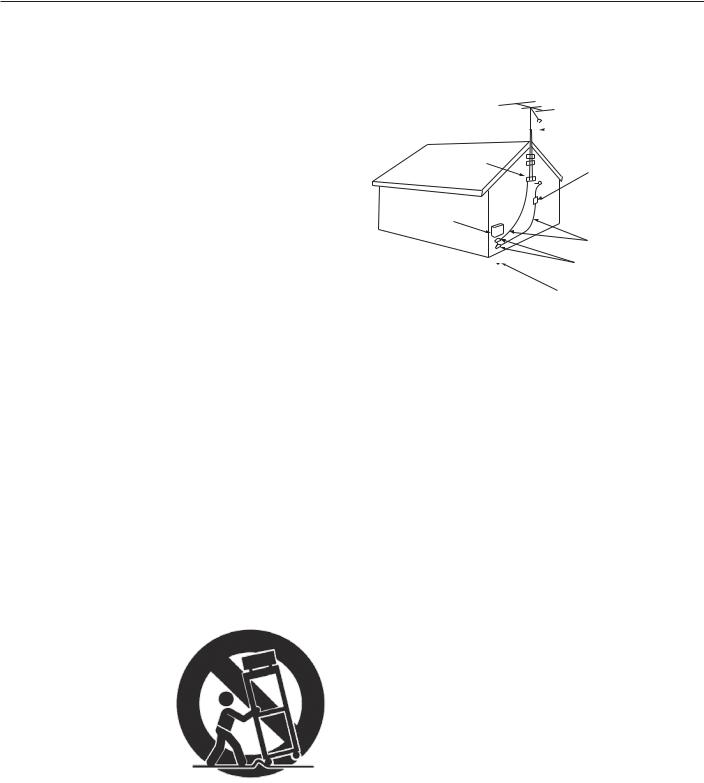
5
Important Safety Instructions |
|
|
Please read the following safeguards for your TV and |
E XAMP LE OF ANTE NNA GR OUNDING |
|
retain for future reference. Always follow all warnings |
||
|
||
and instructions marked on the television. |
|
1)Read these instructions.
2)Keep these instructions.
3)Heed all warnings.
4)Follow all instructions.
5)Do not use this apparatus near water.
6)Clean only with dry cloth.
7)Do not block any ventilation openings. Install in accordance with the manufacturer’s instructions.
8)Do not install near any heat sources such as radiators, heat registers, stoves, or other apparatus (including amplifiers) that produce heat.
9)Do not defeat the safety purpose of the polarized or grounding-type plug. A polarized plug has two blades with one wider than the other. A grounding type plug has two blades and a third grounding prong. The wide blade or the third prong are provided for your safety. If the provided plug does not fit into your outlet, consult an electrician for replacement of the obsolete outlet.
10)Protect the power cord from being walked on or pinched particularly at plugs, convenience
receptacles, and the point where they exit from the apparatus.
11)Only use attachments/accessories specified by the manufacturer.
12)Use only with the cart, stand, tripod, bracket, or table specified
by the manufacturer, or sold with the apparatus. When
a cart is used, use caution when moving the cart/apparatus combination to avoid injury from tip-over.
13)Unplug this apparatus
during lightning storms or when unused for long periods of time.
14)Refer all servicing to qualified service personnel. Servicing is required when the apparatus has been damaged in any way, such as power-supply cord or plug is damaged, liquid has been spilled or objects have fallen into the apparatus, the apparatus has been exposed to rain or moisture, does not operate normally, or has been dropped.
|
|
|
|
|
|
|
ANTE NNA |
|
|
|
|
|
|
|
|
|
|
|
|
|
|
|
LE AD IN WIR E |
GR OUND C LAMP |
|
|
|
||||
|
|
|
|
|
|
|
ANTE NNA |
|
|
|
|
|
|
|
DIS C HAR GE UNIT |
E LE C TR IC |
|
|
(NE C AR TIC LE 810-20) |
||||
|
|
|
|||||
S E R VIC E |
|
GR OUNDING |
|||||
E QUIP ME NT |
|
||||||
|
C ONDUC TOR S |
||||||
|
|
|
|
|
|
||
|
|
|
|
|
|
(NE C AR TIC LE 810-21) |
|
|
|
|
|
|
|
GR OUND C LAMP S |
|
|
|
|
|
|
|
||
|
|
|
|
|
|||
|
|
|
|
|
|
P OWE R S E R VIC E GR OUNDING |
|
|
|
|
|
|
|
E LE C TR ODE S YS TE M |
|
NE C — NATIONAL E LE C TR IC AL C ODE |
|
(NE C AR T 250, P AR T H) |
|||||
Outdoor Antenna Grounding
If an outside antenna or cable system is connected to the TV, be sure the antenna or cable system is grounded so as to provide some protection against voltage surges and built-up static charges.
Replacement Parts
When replacement parts are required, be sure the service technician has used replacement parts specified by the manufacturer or have the same characteristics as the original part. Unauthorized substitutions may result in fire, electric shock or other hazards.
Downloaded From TV-Manual.com Manuals
For assistance call 1(800) 332-2119
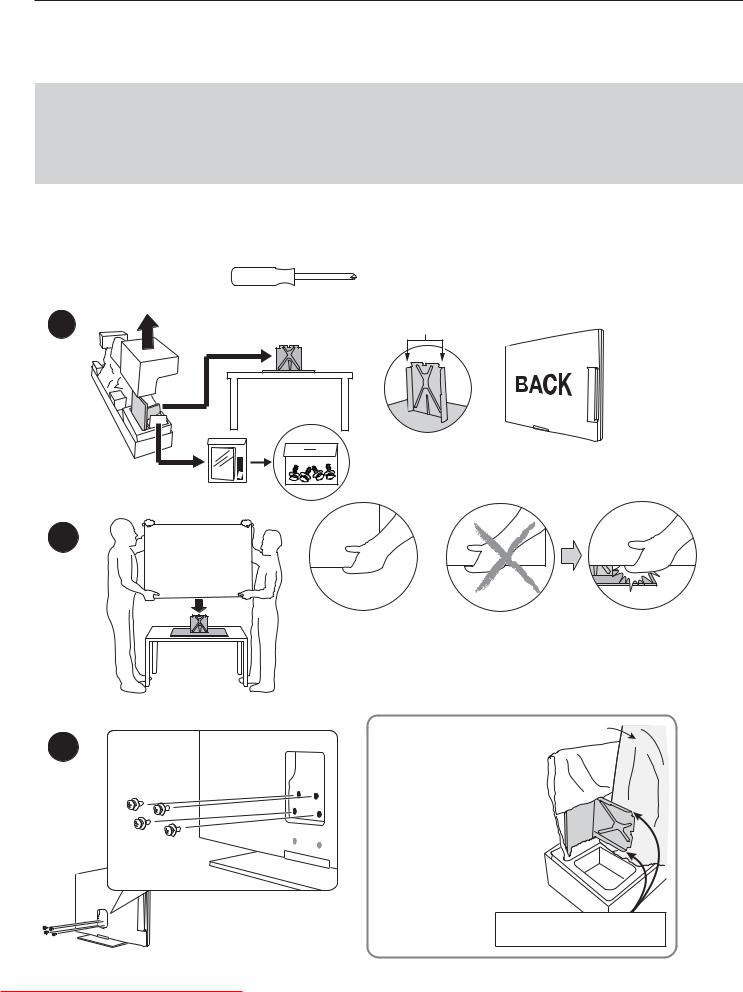
6
Stand Installation
CAUTION
•Using this TV with other than the authorized accessories may cause the TV to become unstable, which can cause damage to the product or possible injury.
•At least TWO PEOPLE are required to install the stand. Support the TV near the corners as shown. Failure to follow these recommendations may result in personal injury and damage to the product.
Note
•40or 46-inch TV: If planning to wall-mount the TV, there is no need to install the stand.
•55-inch TV: The TV comes from the factory with the stand pre-installed.
Required: Phillips Screwdriver
1 |
Extension pieces |
on back of stand |
2 |
BACK |
|
DO support the TV |
DON’T place your hand where it can |
under the corners. |
get caught under the TV. |
Two adults are required to lift the TV.
3
|
TV in protective |
Repacking the Stand |
wrapping |
|
|
CAUTION. Place the |
TV |
stand in the foam insert |
|
with the extension pieces |
|
facing away from the TV. |
|
Otherwise, the TV will be |
|
damaged in transit. |
|
Protect the TV and stand with the original packing material.
Extension pieces on stand must face out, away from TV.
DownloadedFor assistanceFrom TV-Manualcall.com 1(800)Manuals 332-2119
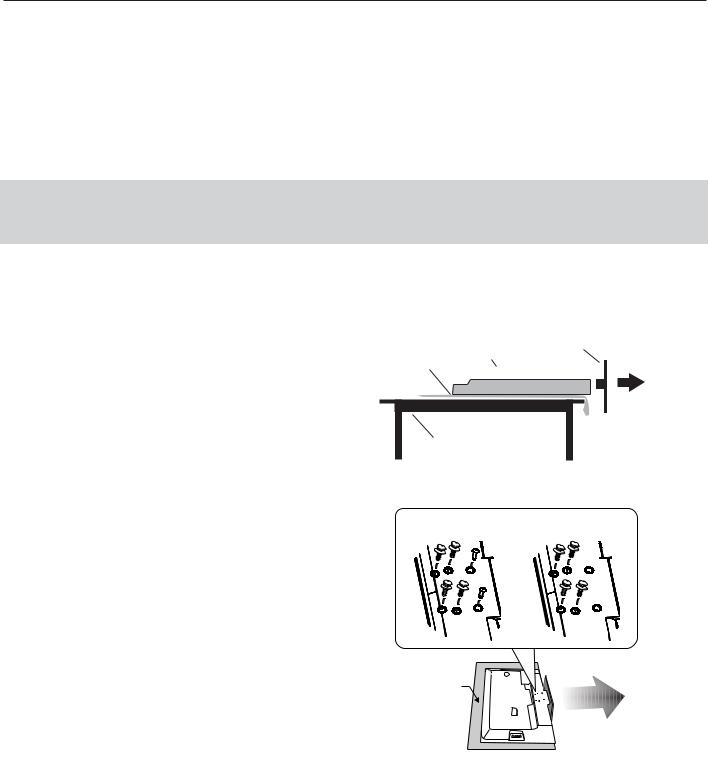
7
Wall-Mounting
To order a wall-mount kit, please contact Peerless Industries, Inc. at (800) 473-3753 or visit
www.peerlessmounts.com. Order wall-mount kit model ST650.
To order a wall-mount kit from Mitsubishi Digital Electronics America, Inc., please visit www.mitsuparts.com or call (800) 553-7278.
Complete installation instructions are included with the kit.
Stand Removal Prior to Wall-Mounting
CAUTION
At least TWO PEOPLE are needed to safely remove the stand. Have one person hold the TV while the other person removes the stand. Failure to follow these recommendations may result in personal injury and damage to the product.
Note
•55-inch TV: Remove the factory-installed stand prior to wall-mounting.
•40or 46-inch TV: If you installed the stand for table-top use, follow these instructions to remove it prior to wall-mounting the TV.
1. |
Disconnect the TV’s AC power cord from the AC |
1SPUFDUJWF |
57 |
4UBOE |
|
power outlet. |
|
|
|
|
TIFFU |
|
|
|
2. |
Spread the protective sheet that was wrapped |
|
|
|
|
|
|
||
|
around the TV on a flat, even surface, such as a |
|
|
|
|
sturdy table. The protective sheet will help prevent |
|
|
|
|
damage to the display. |
5BCMF |
|
|
|
IMPORTANT: To avoid damaging the screen, |
|
|
|
|
|
|
|
|
|
make sure there are no foreign objects under or |
|
|
|
|
on top of the protective sheet. |
|
|
|
3.Position one person on each side of the TV (left and right sides). Have each person firmly grasp their side of the TV and gently place it face down on the protective sheet with the display stand hanging over the edge of the table. See the illustration to the right.
4.Use a magnetic philips screwdriver to remove the stand screws from the recessed holes (see illustration to right). Note: A regular screwdriver can be used with a separate magnetic pick-up tool.
5.While one person holds the TV with both hands, have the other person grasp the stand (see illustration to the right) and remove the stand by pulling it away from the TV in the direction of the large arrow shown in both illustrations.
55-inch TVs |
|
40and 46-inch TVs |
|
||
(6 screws) |
|
(4 screws) |
|
|
|
Protective
Sheet
Pull stand to remove.
Downloaded From TV-Manual.com Manuals
For assistance call 1(800) 332-2119

8
Special Features of Your TV
Your new high-definition widescreen television has many special features that make it the perfect center of your home entertainment system, including:
1080p High-Definition LCD Display System
Easy Connect Auto Input Sensing
Easy Connect™ Auto Input Sensing automatically recognizes when you plug in a device and prompts you to assign a name to it.
Your Mitsubishi LED LCD HDTV uses a full 1920 x 1080 LCD panel to create the picture you see on the screen. All images are displayed at 1080p. The TV uses new Plush 1080p® 5G digital video processing to convert lower-reso- lution signals to 1080p for display.
True120Hz and True240Hz
True120Hz (154 and 164 series) and True240Hz (265 series) make fast-moving images appear smoother and more fluid, free from motion blur. It does this by doubling the traditional progressive scan frame rate and creates new frames of video between the traditional frames to create smoother moving images. True120Hz/True240Hz also smooth film judder (image vibration) that may be present in film-based content such as movies.
16:9 Widescreen Picture Format
Enjoy a full theatrical experience in the comfort of your home. View pictures as film directors intended them. Digital TV broadcasts, DVDs and newer video game consoles support this widescreen format.
Integrated HDTV Tuner
Your widescreen Mitsubishi HDTV has an internal HDTV tuner able to receive both over-the-air HDTV broadcasts (received via an antenna) and non-scrambled digital cable broadcasts, including non-scrambled HDTV cable programming.
High-Definition Video Inputs
•Component Video Inputs. Also called Y/Pb/Pr inputs, these inputs receive standard analog video formats of 480i, 480p, 720p, and 1080i high-defini- tion signals. This provides a high level of flexibility when connecting DVD players/recorders, cable boxes, and satellite receivers.
•HDMI Inputs. These inputs accept digital 480i, 480p, 720p, 1080i, and 1080p video signals plus bitstream and PCM digital stereo signals. The HDMI™ inputs can also accept a variety of PC signals and resolutions.
Used with an adapter, these inputs also accept compatible digital DVI video signals. HDMI inputs provide additional high-performance, high-definition connections for maximum flexibility
in your choice of home theater products. The HDMI inputs are HDCP copy-protection compatible.
Home-Theater Control
HDMI Control
Available on all models. HDMI devices with Consumer Electronics Control (CEC) capabilities may be compatible with the TV’s HDMI Control feature. Compatible devices can receive control signals through the HDMI connection, allowing the TV’s remote control to operate some functions of these devices.
NetCommand with IR Learning
265 Series. NetCommand® supports IR (infrared) control of products such as VCRs, DVD players, cable boxes, and satellite receivers. NetCommand can “learn” remote control signals directly from many devices, allowing you to create a customized NetCommand-controlled hometheater system.
Sound Projector
Sound Projector technology uses the TV’s bank of speakers to create a simulated surround sound effect by reflecting sound off the room walls.
StreamTV™ Internet
StreamTV brings many popular internet applications to your TV. Among them is the VUDU™ movie service, offering the largest on-demand HD movie selection anywhere, featuring full 1080p and 5.1 surround sound. VUDU allows you to enjoy movies with no store visits, no mailing, no late fees and no subscriptions.
ENERGY STAR®
This is an ENERGY STAR® qualified TV. Products that earn the ENERGY STAR prevent greenhouse gas emissions by meeting strict energy efficiency guidelines set by the U.S. Environmental Protection Agency and the U.S. Department of Energy.
This TV uses power within ENERGY STAR guidelines except when Picture Mode is set to Brilliant.
DownloadedFor assistanceFrom TV-Manualcall.com 1(800)Manuals 332-2119

1 Basic Setup and Operation
9 |
Package Contents
Please take a moment to review the following list of items to ensure that you have received everything.
Remote Control
AA
Two AA Batteries
AA
Basic Owner’s Guide
Quick Setup Guide
Product Registration
Card
Power Cord
Cable Ties
Stand Screws (40and 46-inch TVs only)
265 Series. Calibration
Microphone
Installing the Remote Control
Batteries
1.Remove the remote control’s back cover by gently pressing in the tab and lifting off the cover.
2.Load the batteries, making sure the polarities
(+)and (-) are correct. For best results, insert the negative (-) end first.
3.Snap the cover back in place.
The remote control requires two AA alkaline batteries.
2
Downloaded From TV-Manual.com Manuals
For assistance call 1(800) 332-2119
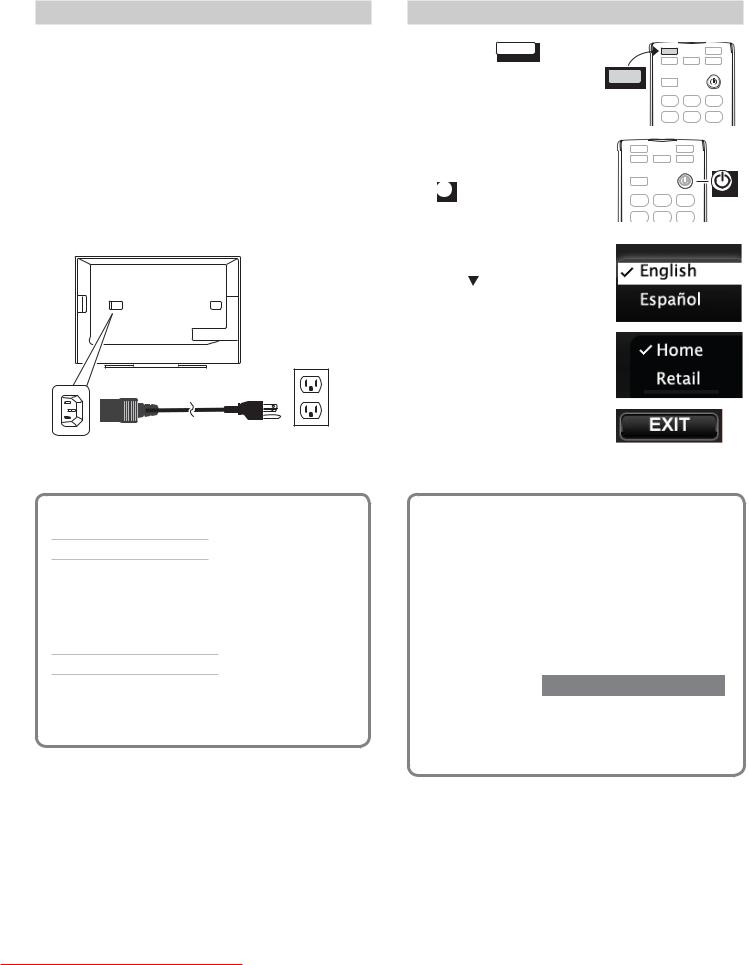
10 |
1. Basic Setup and Operation |
Before You Begin
1.Review the important safety, installation, and operating information at the beginning of this book.
2.Choose a location for your TV.
•See the stand-installation or wall-mounting requirements starting on page 6.
•Allow at least four inches of space on all sides of the TV to help prevent overheating. Overheating may cause premature failure of the TV.
•Avoid locations where light may reflect off the screen.
3.Install the batteries in the remote control.
4.Plug the TV into an AC power outlet.
TV power connection
TV Tips
Turning the TV On or Off
•Point the emitter (bulb) end of the remote control at the front of the TV and press the POWER button.
•Press the POWER button on the TV control panel.
Controlling Sound Volume
•Press VOL to adjust the sound level.
•See also “Controlling A/V Receiver Sound Volume” on page 32.
First-Time Power-On
1. Press the TV key to TV
ensure that the remote |
TV |
|
control is in TV mode. |
||
|
2. Aim the emitter end of the remote control at the TV and press the POWER key  . Wait for the Welcome screen.
. Wait for the Welcome screen.
3.If you wish to change the menu language to Español, press .
4.Press to move to the energy-mode selections. Select Home.
to move to the energy-mode selections. Select Home.
5.Press to highlight EXIT. Press ENTER to clear the menu.
to highlight EXIT. Press ENTER to clear the menu.
Welcome Screen Energy Options
•Mitsubishi recommends the Home setting, which uses power within ENERGY STAR® guidelines.
•The Retail setting looks best under bright lighting. In this mode, the TV uses power in excess of ENERGY STAR guidelines.
This table compares energy choices offered in the
Welcome screen.
|
Home |
Retail |
|
|
|
Picture Mode |
Bright |
Brilliant |
|
|
|
Backlight Level |
Reduced |
Full Brightness |
|
Brightness |
|
DownloadedFor assistanceFrom TV-Manualcall.com 1(800)Manuals 332-2119
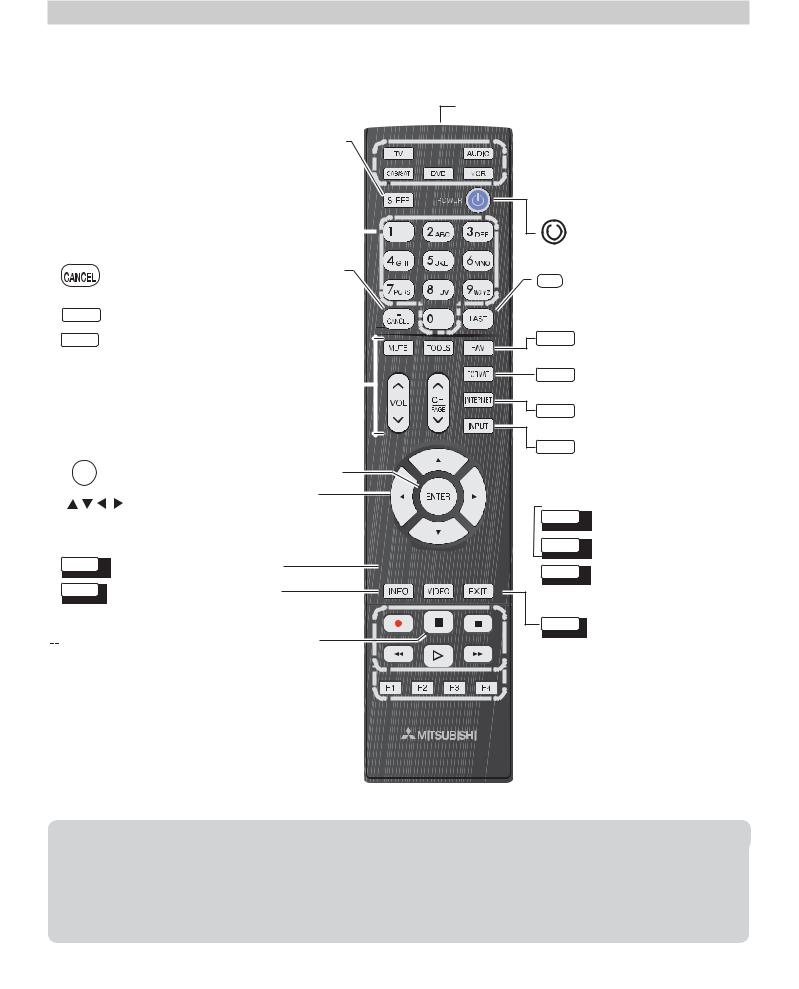
1. Basic Setup and Operation |
11 |
TV Controls
Remote Control
For more on use and care of the remote control, see page 84.
|
|
|
|
|
|
Sleep Timer, page 29 |
|
|
|
|
|
|
|
|
|
Number/letter keys |
|
|
|
|
|
|
|
|
|
Channel tuning, page 16 |
|
|
|
|
|
|
|
|
|
|
|
||
|
|
|
|
|
|
Pass-code entry, page 57, |
|
|
|
|
|
|
|
|
|
page 43 |
|
|
|
|
|
|
|
|
|
|
|
||
|
|
|
|
|
Adds a separator in digital channel |
|
|
||
|
|
|
|
|
|
|
|||
|
|
|
|
|
numbers. Clears some menu entries. |
|
|
||
|
|
|
|
|
|
Mutes the TV speakers. |
|
|
|
MUTE |
|
|
|
|
|
||||
|
|
|
|
|
Displays shortcuts for the number keys. |
|
|
||
TOOLS |
|
|
|||||||
|
|
|
|||||||
|
|
|
|
|
Press to check if shortcuts are available |
|
|
||
|
|
|
|
|
|
||||
|
|
|
|
|
for the current device. See the next |
|
|
||
|
|
|
|
|
page. |
|
|
||
|
|
|
|
|
|
|
|||
|
|
VOL Controls volume of TV speakers. |
|
|
|||||
|
|
CH |
|
|
|
|
|
||
|
|
|
Changes channels; moves to another |
|
|
||||
|
|
PAGE |
|
|
page in a menu or list. |
|
|
||
|
|
|
|
|
|
|
|||
|
ENTER |
|
|
Selects a channel number or menu item. |
|
|
|||
|
|
|
|
|
|
Navigation and adjustment |
|
|
|
|
|
|
|
|
|
|
|
||
|
|
|
|
|
|
controls |
|
|
|
Emitter (Bulb) End
 TV CAB/SAT DVD AUDIO VCR
TV CAB/SAT DVD AUDIO VCR
Press the key for the device type to
control. Leave in TV mode for normal TV viewing.
|
|
|
Powers TV on or off. |
||
|
|
|
Returns to the previous channel; |
||
|
|
||||
LAST |
|||||
|
|
|
moves back one menu |
||
|
|
|
|||
|
|
|
|
Displays up to nine favorite |
|
|
FAV |
|
|||
|
|
|
|
|
sources, page 29. |
|
|
|
|
||
|
|
|
Changes picture shape, |
||
FORMAT |
|
|
|||
|
|
|
|
|
page 18 |
|
|
|
|
|
|
|
|
Connects to StreamTV internet |
INTERNET |
||
|
|
content, page 42. |
|
||
|
|
Press to select a TV input, |
INPUT |
|
|
|
|
page 16. |
|
|
AUDIO Audio settings, page 49
 VIDEO Video settings, page 46
VIDEO Video settings, page 46
GUIDE ChannelView listings, page 30.
INFO TV status or TV help.
 (Pause) Freezes a broadcast TV picture.
(Pause) Freezes a broadcast TV picture.
Record/Playback controls for external devices When remote control is programmed, page 73 HDMI control, page 83
265 Series: With NetCommand, page 66



 MENU Displays or clears the TV main
MENU Displays or clears the TV main
menu (page 46). Also steps
back one menu. EXIT Clears all menus.
 F1–F4. 265 Series. Special keys for use with NetCommand IR control. See “Initial NetCommand Setup”.
F1–F4. 265 Series. Special keys for use with NetCommand IR control. See “Initial NetCommand Setup”.
Note: To operate other audio/video devices using the |
• 265 Series |
|
TV’s remote control, use any of these methods: |
-- See page 60 for NetCommand IR “Learning” of |
|
• See Appendix A, “Programming the Remote |
device keys. |
|
-- For use of specific keys with NetCommand- |
||
Control.” |
||
controlled devices, see “Special Operation |
||
• For HDMI devices compatible with the TV’s HDMI |
||
Methods,” page 64. |
||
Control feature, see Appendix C. |
||
|
Downloaded From TV-Manual.com Manuals
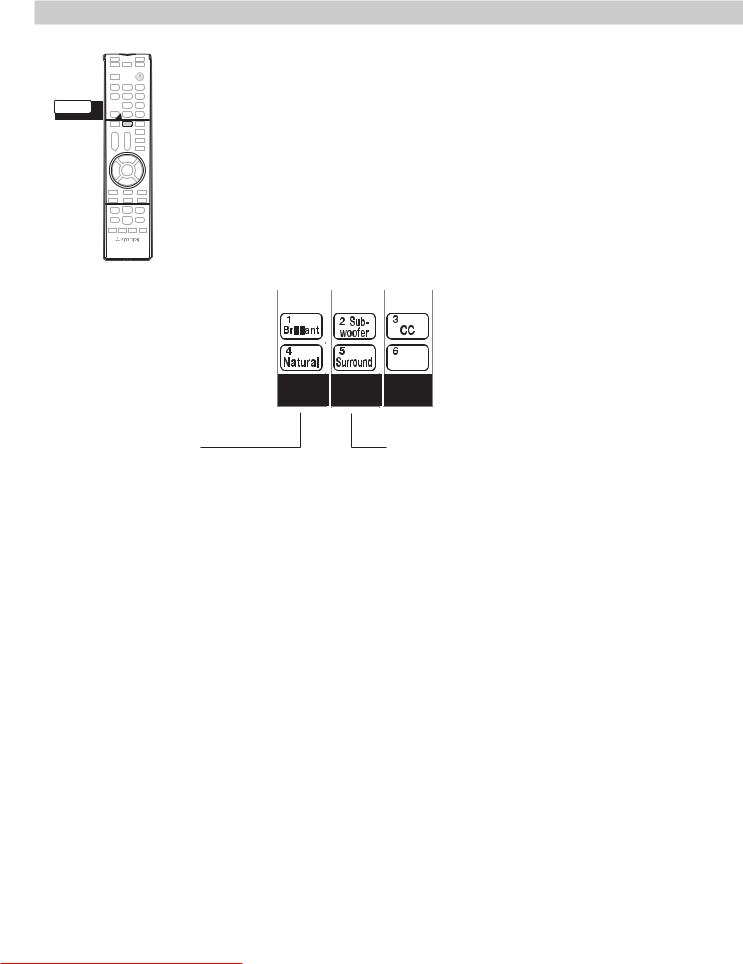
12 |
1. Basic Setup and Operation |
TV Controls, continued
TOOLS 
TOOLS
The TOOLS Key and Menu
Press the TOOLS key to check for shortcuts. The Tools menu lists shortcut keys for common functions. Press the number key to activate the shortcut. See the sample menu below.
•Shortcuts specific to the current device are in the third column.
•Shortcuts may be available for a CEC-enabled device. See Appendix C, “HDMI Control of CEC Devices,” page 81.
•265 Series. After setting up NetCommand control for a device, check the Tools menu for shortcuts. See page 62.
Tools |
|
Device-Specific Shortcuts |
|
||
|
Availability varies, depending on equip- |
|
|
|
|
|
|
|
|
|
ment features and setup. |
|
PICTURE |
|
SOUND |
|
TV |
|||
|
|
|
|
|
|
3 CC. Turns closed |
page 51 |
|
|
|
|
|
|
|
|
|
|
|
|
|
|
captions on/off |
|
|
|
|
|
|
|
|
|
|
|
|
|
|
|
|
|
Sample Tools menu
Picture Shortcuts
1 |
Picture Mode Brilliant |
page 46 |
|
|
|
4 |
Picture Mode Natural |
|
|
|
|
164 and 265 Series. Brilliant and |
page 48 |
|
Natural Picture Modes are the |
|
|
default choices. If your installer has |
|
|
set up special Picture Modes in the |
|
|
Picture > Advanced menu, select |
|
|
them from this menu. |
|
|
|
|
|
7 |
Backlight turns off the backlight. |
--- |
Press any number key to turn the |
|
|
backlight back on. |
|
|
|
|
|
Sound Shortcuts
2 |
Subwoofer. Turns on or off audio to a con- |
page 50 |
nected subwoofer. |
|
|
5 |
Surround. Selects Sound Mode Surround |
page 50 |
|
|
|
8 |
Night. Selects Sound Mode Night |
|
|
|
|
DownloadedFor assistanceFrom TV-Manualcall.com 1(800)Manuals 332-2119
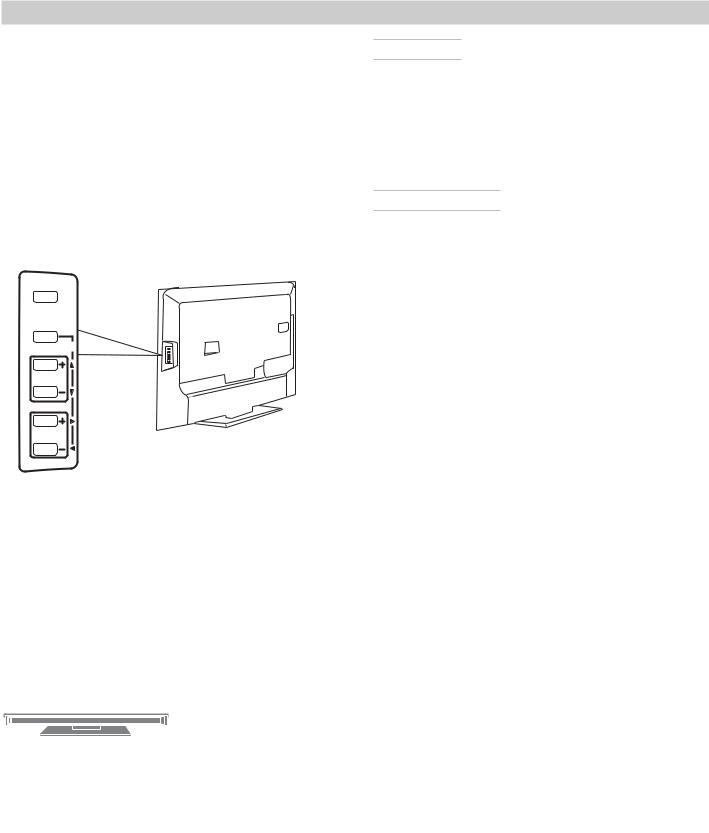
1. Basic Setup and Operation |
13 |
TV Controls, continued
TV Control Panel
Buttons on the control panel duplicate some keys on the remote control.
•To display the main menu, press INPUT and VOL+
simultaneously for about 10 seconds. Press and hold INPUT and VOL+ for 10 seconds to clear the menu.
•Refer to left labels when no TV menus are displayed.
•Refer to right labels when using TV menus or after activating a special function.
POWER
INPUT
ENTER
CH
VOL
TV control panel
System Reset
If the TV fails to respond to the remote control, the control-panel buttons, or will not power on/off, perform System Reset. Recent setting changes made before using System Reset may be lost.
To perform System Reset, press and hold the POWER button on the control panel for 10 seconds.
Panel-Lock Release
•To release the Panel Lock using the TV control panel, press and hold the INPUT button on the control panel for ten seconds. If the TV is off, press the POWER button to make it power on.
•To activate the Panel Lock, use the Lock menu, page 59.
POWER Indicator
POWER
Key
 Off
Off
Steady On
 Slow Blinking
Slow Blinking
Fast Blinking
LED Color |
TV Condition |
|
|
|
|
None |
TV is powered off. Normal operation. |
|
|
||
|
|
|
Green |
TV is powered on. Normal operation. |
|
|
||
|
|
|
Green |
TV powered off, auto-on TV Timer is set. |
|
Normal operation. TV can be turned on at any time. |
||
|
||
|
|
|
Red/ |
TV may require service. |
|
• Hold power button on front panel for 10 seconds to reset TV. |
||
Yellow |
||
|
• If LED continues to flash red and yellow after reset, turn off the |
|
|
TV and unplug it from the AC power source. Wait one minute |
|
|
and then plug the set back in. |
|
|
• If LED continues to flash red and yellow, go to |
|
|
www.mitsubishi-tv.com or call 1-800-332-2119 to receive Autho- |
|
|
rized Service Center information. |
|
|
You may be asked to count how many times the LED flashes |
|
|
each color to assist in troubleshooting. |
|
|
|
Downloaded From TV-Manual.com Manuals
For assistance call 1(800) 332-2119
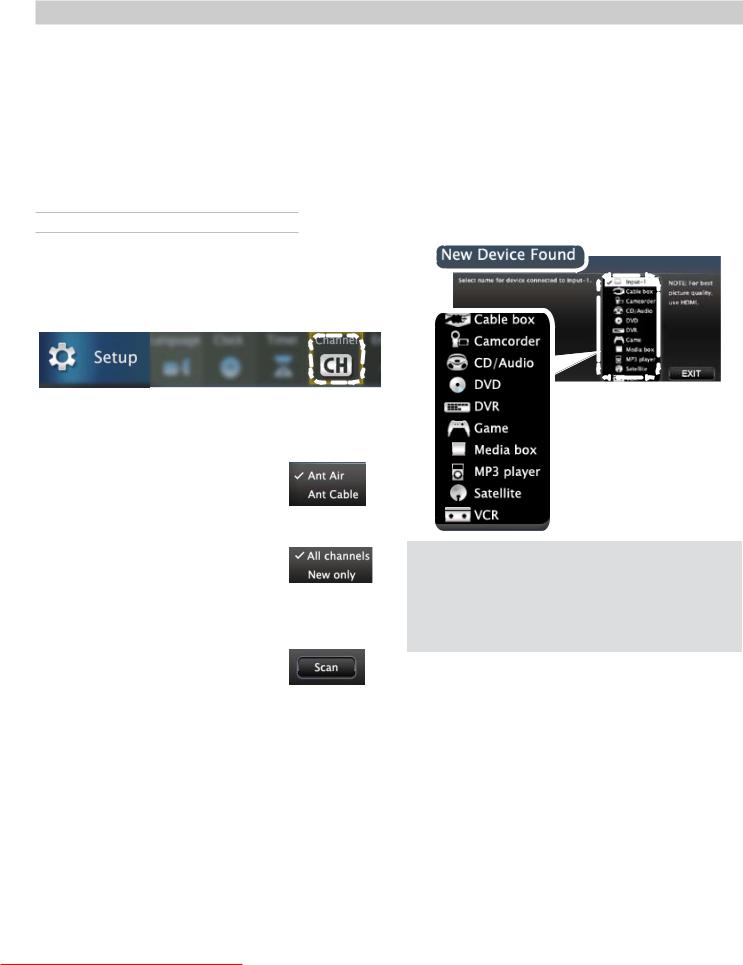
14 |
1. Basic Setup and Operation |
Setting Up TV Inputs
Using the ANT (Antenna) Input
If using an antenna or direct cable service (no cable box), connect the incoming coaxial cable to the TV’s ANT input. Refer to page 26.
You must perform a channel scan to enable reception of digital channels. If you skip this step, the TV will receive only analog channels. The channel scan will search for high-definition and standard-definition channels available in your area.
Memorizing Channels with Channel Scan
For the ANT input
To start channel memorization
1.Power on the TV.
2.Press MENU and open the Setup > Channel menu.
Start channel memorization from the Setup > Channel menu.
3.Press to enter the menu.
to enter the menu.
4.Highlight Ant Air if connected to an over-the-air antenna. Highlight Ant Cable for service over direct cable (no cable box). Press ENTER to add a check.
5.Select the scan type.
•For first-time setup, highlight All channels.
•To scan for channels not already in memory, highlight New only. Press ENTER to add a check.
6.Highlight Scan and press ENTER. Channel memorization may take up to 15 minutes to complete.
To stop channel memorization before completion, press CANCEL.
At any time after Channel Scan,
•Use the Setup > Channel > Edit menu (page 53) to add or delete individual channels from memory.
•Perform an additive scan with the New only option to add channels not already in memory.
•Repeat the All channels scan if you move the TV to a new geographic area with a different channel line-up or reposition the antenna.
Setting Up Inputs with Auto Input Sensing
1.Power on the TV.
2.Power on the devices to ensure detection.
3.Connect one device to the TV, making note of the TV input jack.
The TV will display the New Device Found screen if the connection type is detectable.
4.Highlight the device type in the on-screen list and press ENTER. The name you select here will appear in the Input Selection menu.
Sample New Device
Found screen.
Important Note for NetCommand Users
265 Series. Be sure to select the correct device type here. Although you can change the device type later using the Inputs > Name menu, any “learned” NetCommand IR codes will be erased when you make the change.
5.Press EXIT to close the New Device Found screen.
6.Repeat the preceding steps for each for each additional device you want to add.
DownloadedFor assistanceFrom TV-Manualcall.com 1(800)Manuals 332-2119
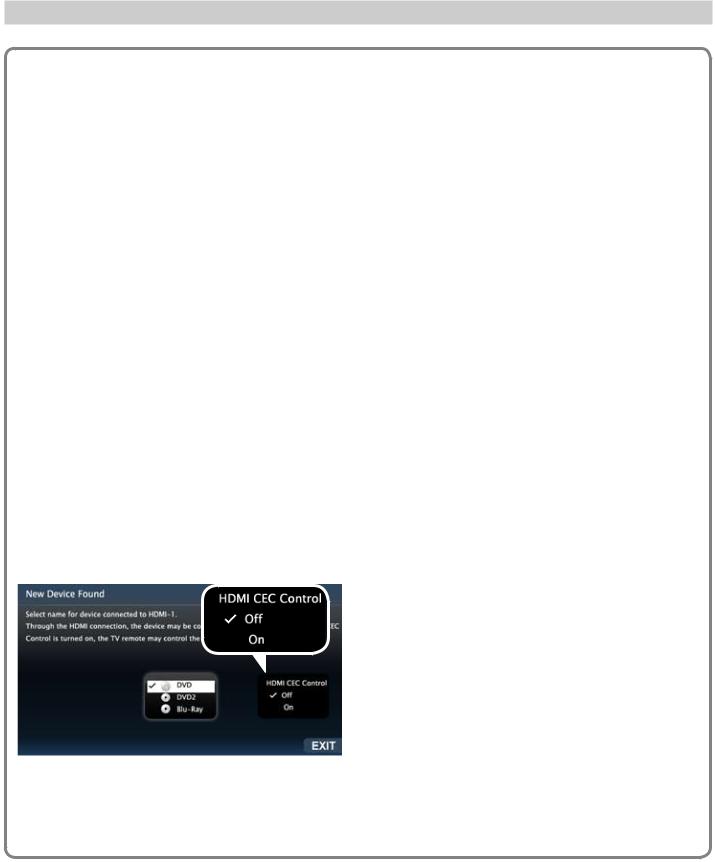
1. Basic Setup and Operation |
15 |
Setting Up TV Inputs, continued
About Auto Input Sensing
This TV’s Easy Connect™ Auto Input Sensing feature detects the following connections automatically:
•Analog video jacks from inputs 1, 2, and 3
•HDMI inputs (when powered on)
•USB device containing photo and music files (JPG and MP3 formats).
Auto Input Sensing for Most Devices
When you first connect a device, the TV will:
a.Detect the connected device and automatically switch to it.
b.Prompt you to identify the device type.
c.Repeat these steps for other newly detected devices.
When You First Connect a Device
•Most Device Types. Select the device type from the on-screen list. The device type you select here will appear as an icon in the Input Selection menu.
•A/V Receiver. For an HDMI-equipped A/V receiver, select AVR from the list of device types if the A/V receiver is not recognized automatically.
•HDMI CEC Devices Compatible with the TV’s HDMI Control Feature. Compatible CEC-enabled HDMI-equipped devices are often
recognized automatically by the TV. HDMI Control may allow you to control some functions of a CECenabled device. See Appendix C, “HDMI Control of CEC Devices.”
New Device Found screen for a device with HDMI control enabled. Select On if you want to enable the TV’s HDMI control of the device. In some cases, as in the example above, you will also be prompted to select a device name.
Tips on Auto Sensing
•Choose a different name for each input.
•The antenna input (ANT) is never detected, although you can turn off the unused antenna input in the Inputs > Name menu.
•Change the device type displayed in the Input Selection menu by using the Inputs > Name menu (page 55).
•Some HDMI devices can automatically tell the TV what name to use in the Input Selection menu and you will be unable to change the name.
•The TV is unable to detect a new connection if the current input is USB, Bluetooth®, or internet. Switch to a different input before connecting.
•265 series. Any “learned” NetCommand IR codes will be erased if you change the device type in the Inputs > Name menu.
Reactivating Auto Input Sensing for an HDMI Input
After you disconnect an HDMI device, Auto Input Sensing is temporarily disabled. Perform these steps:
1.Disconnect the HDMI device.
2.Delete the removed HDMI device in the Inputs > Name menu (see “Removing an HDMI Device,” page 83).
3.Connect the new device and the New Device Found screen will display.
Downloaded From TV-Manual.com Manuals
For assistance call 1(800) 332-2119
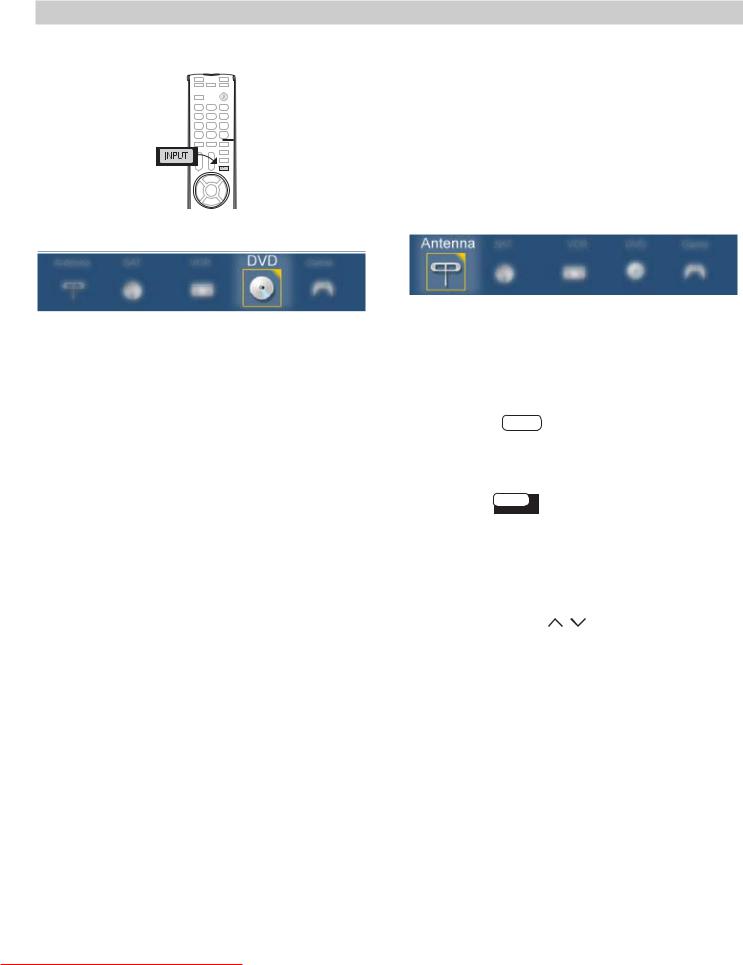
16 |
1. Basic Setup and Operation |
|
|
|
|
Basic TV Operation
Selecting an Input to Watch
1. Press INPUT.
2. Press
 and
and to highlight an input icon.
to highlight an input icon.
Sample Input selection menu, DVD input selected
3.Press ENTER to switch to the input.
4.To control the input device, use the device’s remote control or see “Introduction to Home-Theater Control,” page 45.
Note: In most cases, to see a named icon for a connected device (as in the samples), you must first assign a name either
•When the device is first connected and the
New Device Found menu offers a choice of names.
•By using the Inputs > Name menu to assign or change a name at any time after the TV has detected the connection.
More About the Input Selection Menu
•To assign helpful names to the icons, see the
Inputs > Name menu, page 55.
•To remove unwanted Antenna, Bluetooth®, or HDMI device icons from the Input Selection menu, see the Inputs > Name menu, page 55.
•To rearrange the icons, see the Inputs > Order menu, page 56.
Watching Broadcast TV
TV Connected to an Antenna or Direct Cable Service (no cable box)
Note: Perform channel memorization to enable reception of digital channels. See page 14.
1.Press INPUT to display the Input Selection menu.
2.Highlight the antenna or cable icon and press ENTER.
Sample Input Selection menu, antenna input selected
3.To tune to a channel from the ANT input, use any of these methods.
•Enter the channel number using the number keys on the remote control and press ENTER.
For a two-part digital channel, such as 3-1, press 3 — 1 ENTER .
CANCEL
•Press CH to change channels one channel at a time.
•Press and hold CH to speed through channels.
•Press LAST to return to the previous channel.
•Use the Fav (Favorites) feature to tune to up to nine favorite channels. See page 29.
•Press GUIDE to display ChannelView channel listings, highlight a channel number, and press ENTER to tune.
•Set up ChannelView custom channel banks
and use the CH / key to tune to predefined groups of channels. See page 30.
DownloadedFor assistanceFrom TV-Manualcall.com 1(800)Manuals 332-2119
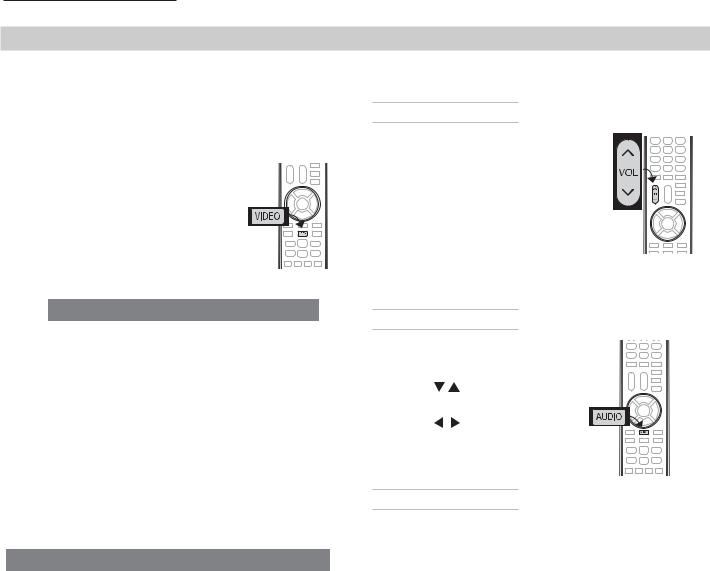
1. Basic Setup and Operation |
17 |
Basic TV Operation, continued
Picture Settings
1.To get the best picture under different viewing conditions, set the Picture Mode first before changing other video settings. See page 46.
a. Press VIDEO.
b. Press 
 until Picture Mode displays.
until Picture Mode displays.
c. Press 
 to make one of these selections:
to make one of these selections:
Name |
When to Use |
Brilliant |
Under bright light |
|
|
Game |
With gaming consoles (inputs |
|
named Game or PC only) |
Bright |
For most daytime viewing |
|
|
Natural |
For most nighttime viewing |
|
|
2.Press 
 to display the name of another adjustment.
to display the name of another adjustment.
3.Press 
 to make the adjustment.
to make the adjustment.
4.Press EXIT to clear the display.
Additional picture options are available through these menus:
Menu Name |
Page |
Picture > Video |
46 |
|
|
Picture > Picture Plus |
47 |
|
|
Picture > Perfect (265 Series) |
48 |
Picture > Advanced (164 and 265 Series) |
48 |
|
|
Basic Audio Controls
Controlling Sound Volume
• Press VOL to adjust the sound level of the TV speakers.
• Control subwoofer volume with an on-screen slider. See page 49. Set
Sound > Global > Subwoofer to
On to make this adjustment available.
•See also “Controlling A/V Receiver Sound Volume” on page 32.
Changing Audio Settings (TV Speakers Only)
1. |
Press AUDIO. |
|
2. |
Press |
to find the adjust- |
|
ment you want. See page 49. |
|
3. |
Press |
to change. |
Changing the Audio Output
To switch from the internal TV speakers to an external sound system,
1.Press AUDIO.
2.Press 
 to display the TV Speakers option.
to display the TV Speakers option.
3.Press 
 to change to Off.
to change to Off.
TV Care
See page 84.
Assistance
•For troubleshooting, service, and product support, see Appendix E, starting on page 85.
•For warranty information, see page 99.
Downloaded From TV-Manual.com Manuals
For assistance call 1(800) 332-2119
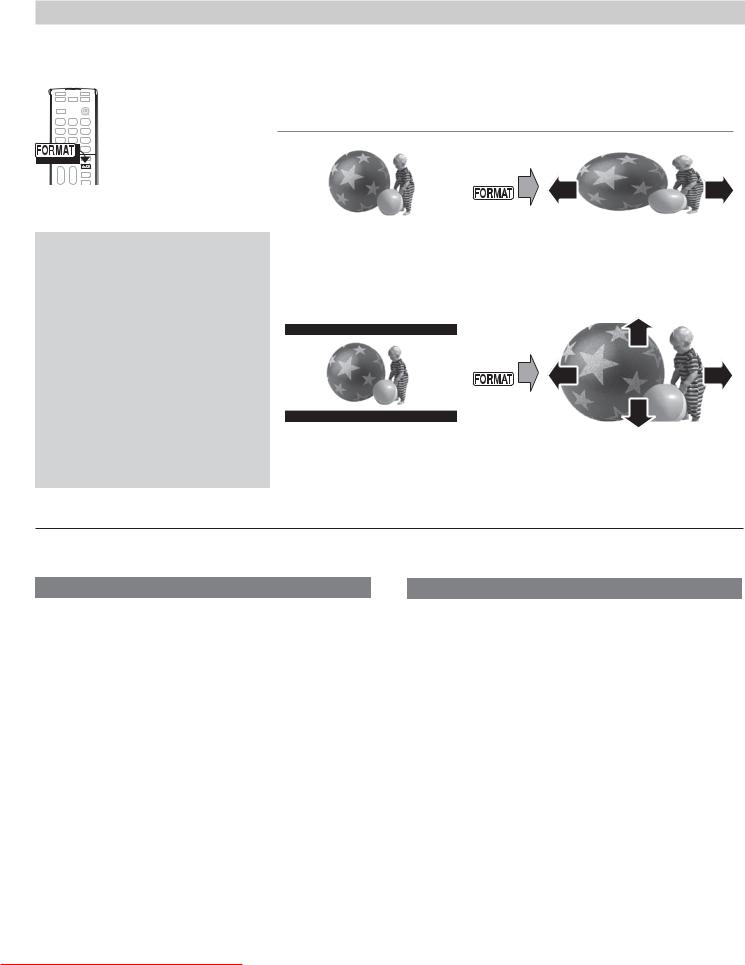
18 |
1. Basic Setup and Operation |
Basic TV Operation, continued
The FORMAT Key and Picture Shape
Repeatedly press the FORMAT key to cycle
through displays for the
current program. The
TV will remember the
format you last used on each input.
For details, see page 33
Important
Black bars at the edges of the screen are common in HD pictures. Black bars are not a defect of the TV.
•Black bars are added by broadcasters to fill the 16:9 screen area while preserving the original aspect ratio of the picture.
•Your cable box, satellite receiver, or other device may also be altering the broadcast picture.
If your device offers output in native format, try using it with Mitsubishi picture formats.
Sample Uses of the FORMAT Key
You can use the FORMAT key to reduce or eliminate black areas at the edges of the picture.
|
|
|
|
|
|
Press |
|
|
|
||
|
|
|
|
|
|
|
|
|
|
|
|
|
|
|
|
|
|
|
|
|
|
|
|
|
Squarish 4:3 image is |
|
Wide Expand mode stretches |
||||||||
|
narrower than the 16:9 |
|
the picture sideways to fill the |
||||||||
|
screen; unused areas at the |
|
screen. |
||||||||
|
sides are filled with black. |
|
|
|
|
|
|
||||
|
|
|
|
|
|
|
|
|
|
|
|
|
|
|
|
|
|
Press |
|
|
|||
|
|
|
|
|
|
|
|
||||
|
|
|
|
|
|
|
|
||||
|
|
|
|
|
|
|
|
|
|
|
|
|
|
|
|
|
|
|
|
|
|
|
|
|
|
|
|
|
|
|
|
|
|
|
|
|
Wide 2.35:1 anamorphic DVD |
|
Zoom mode. The picture fills |
||||||||
|
image; unused areas at the |
|
the screen. All four edges are |
||||||||
|
top and bottom are filled with |
|
cropped in this mode. |
||||||||
|
black (letterbox effect). |
|
|
|
|
|
|
||||
More TV Features
Feature |
Page |
Parental controls (Lock menu) |
57 |
|
|
Audio Lock (controls your sound system with |
74 |
the TV’s remote control left in TV mode.) |
|
|
|
TV Clock. Set the TV Clock if you plan to use |
52 |
the TV Timer (page 52) or ChannelView (page |
|
30). |
|
|
|
Favorite channels or sources |
29 |
|
|
ChannelView and custom channel collections |
30 |
|
|
Changing the input names that appear in the |
55 |
Input Selection menu (Inputs > Name menu) |
|
|
|
Digital camera images and mp3 music files |
34 |
|
|
164 and 265 Series. Listening to a wireless |
37 |
audio device with the TV speakers |
|
|
|
StreamTV™ internet access |
42 |
|
|
Feature |
Page |
Programming the remote control to operate |
73 |
other A/V devices |
|
|
|
Controlling compatible devices using HDMI |
81 |
CEC control |
|
|
|
265 Series. Controlling A/V devices with Net- |
60 |
Command |
|
|
|
DownloadedFor assistanceFrom TV-Manualcall.com 1(800)Manuals 332-2119
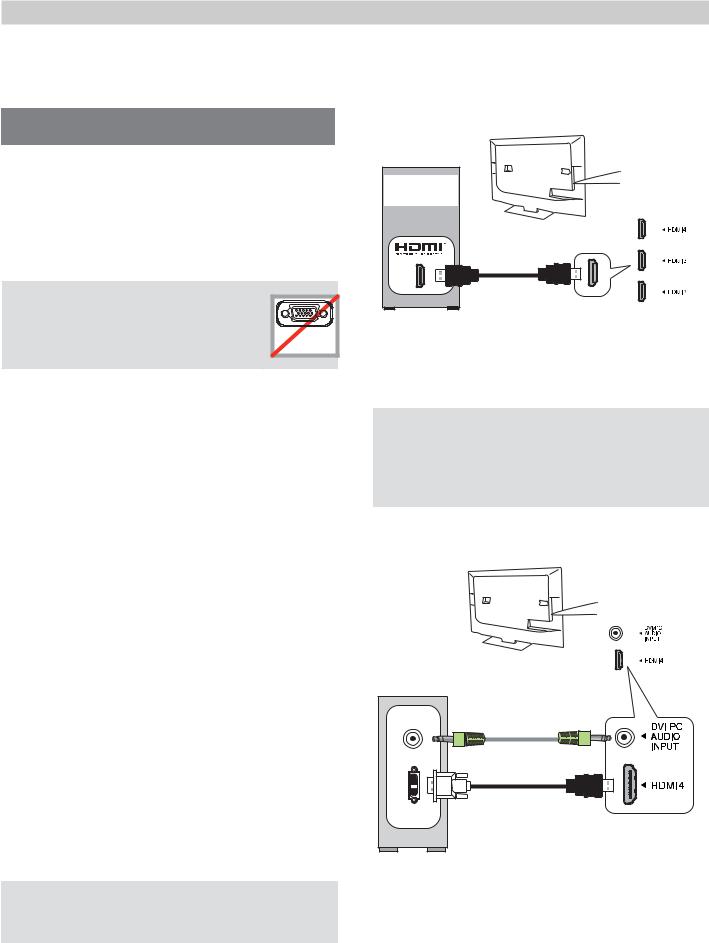
1. Basic Setup and Operation |
19 |
Using the TV with a Personal Computer
Connecting a Computer to the TV
Use one of the connection methods listed below based on your computer’s video output.
Computer |
Video Connection |
Audio |
|
Video Output |
Connection |
||
|
|||
Digital DVI |
DVI-to-HDMI cable |
Analog audio |
|
|
or an HDMI cable |
cable with mini |
|
|
with a DVI-to-HDMI |
plugs |
|
|
adapter |
|
|
|
|
|
|
HDMI |
HDMI-to-HDMI |
No additional |
|
|
cable |
audio connec- |
|
|
|
tion is required. |
|
|
|
|
IMPORTANT |
|
|
This TV accepts digital computer |
|
|
video signals only. This TV is not |
VGA |
|
compatible with VGA (analog) |
||
PC MONITOR OUT |
||
computer video. |
||
|
1.Connect the computer’s digital signal output to one of the TV’s HDMI jacks. See the connection diagrams for the method suited to your equipment.
2.Connect the computer’s audio output using one of these options:
•For digital DVI video signals, connect the analog audio output to the TV’s DVI/PC AUDIO INPUT jack.
•For HDMI signals, no additional audio connection is required.
Note: If you are unable to hear audio from the computer, there may be an incompatibility in the computer’s hardware, software, or internal settings. Consult a trained computer technician for advice.
3.Power on the TV and computer. The TV will detect the connection and display the New Device Found screen.
4.In the New Device Found screen, press 
 to highlight PC in the list of device types. It is important to use the name PC so that the TV processes the PC signal correctly.
to highlight PC in the list of device types. It is important to use the name PC so that the TV processes the PC signal correctly.
5.Highlight EXIT and press ENTER to close the New Device Found screen.
Note: If your computer provides digital audio output (coaxial or optical), you can connect it directly to a digital A/V receiver and bypass the TV.
Downloaded From TV-Manual.com Manuals
HDMI Connection
Mitsubishi recommends using high-speed HDMI cables to connect newer devices incorporating HDMI technology.
Computer with
HDMI output
HDMI-to-HDMI |
cable |
TV
An HDMI-to-HDMI connection carries all video and audio on a single cable.
HDMI and Digital Surround Sound
The TV’s HDMI inputs can receive digital surround sound from an HDMI device. Use an HDMI connection if you want to hear digital surround sound from the TV’s internal speaker array.
DVI Video Connection
Computer with Digital DVI output
AUDIO |
TV |
OUT |
|
|
Audio cable |
DVI OUT |
DVI-to-HDMI |
cable |
A DVI connection from a personal computer requires a separate audio connection.
For assistance call 1(800) 332-2119

20 |
1. Basic Setup and Operation |
Using the TV with a Personal Computer
Computer Video Adjustments
1.Power on the computer.
2.Select PC from the Input Selection menu. To do this, press INPUT to open the Input Selection menu, move the highlight to the PC icon, and press ENTER.
Tip
Set the computer’s screen saver to display a pattern after several minutes of inactivity. This acts as a reminder that the TV is powered on.
3.Working from the computer, change the resolution of the computer image. View the computer image on the TV and maximize the computer resolution while maintaining a suitable aspect ratio for the image.
4.Perform TV video adjustments. VIDEO repeatedly to access videoadjustment options.
5.Press FORMAT repeatedly to find the picture shape best suited to the image. See the chart on this page showing how different computer resolutions can be displayed on the TV.
Computer Display Formats
Computer Signal |
As Displayed on TV Screen |
||
Original Format |
4 X 3 |
16 X 9 |
|
Standard |
Standard |
||
|
|||
VGA |
|
|
|
640 X 480 |
|
|
|
SVGA |
|
|
|
Distortion in Computer Images
Computer images may show distortion when viewed on the TV, e.g., lines that should be straight may appear slightly curved.
Image Resolution
Your Mitsubishi TV can display the resolutions shown in the chart from standard VGA (640 x 480) through 1920 x 1080 signals at a refresh rate of 60 Hz.
In most cases, the computer will select the best resolution match to display on the TV. You can override this setting if wish. Refer to your computer operating system’s instructions for information on changing the screen resolution.
You may need to restart the computer for changes to take effect.
Original Format |
Standard |
Zoom |
XGA
1024 X 768
PC 720p
1280 X
WXGA 1360 X 768
SXGA
Original Format |
Standard |
PC 1080p
1920 X 1080
DownloadedFor assistanceFrom TV-Manualcall.com 1(800)Manuals 332-2119

2 TV Connections
21 |
Before You Begin
Auto Input Sensing
The TV’s Auto Input Sensing feature automatically recognizes many connections and prompts you to identify the type of device connected. See page 15 for more on Auto Input Sensing.
Connection Types
Use the connection types available on your input devices that will give the best video quality. For example, choose HDMI over component video; choose component video over composite video.
Picture Quality
For best picture quality, route signals directly from the source device to the TV whenever possible.
Surround Sound
•To use the surround sound capabilities of the TV’s speaker array, you must connect the digital surround sound source to the TV on either
-- An HDMI input
-- The ANT antenna input
•For best surround sound audio quality from an external sound system, route audio-carrying cables from the source device directly to your sound system.
IMPORTANT
Accessory items such as cables, adapters, splitters, or combiners required for TV connections are not supplied with the TV. These items are available at most electronics stores.
Connection Types and Audio/Video Quality
|
|
|
|
|
|
VIDEO QUALITY |
|
|
|
|
|
|
|
|
|
AUDIO QUALITY |
|
|
|
|
||||||||||||||||||||||||
|
|
BEST |
|
|
|
|
GOOD |
|
|
|
|
|
|
BEST |
|
|
|
|
GOOD |
|||||||||||||||||||||||||
|
|
|
|
|
|
|
|
|
|
|
|
|
|
|
|
|
|
|
Component |
Composite |
|
|
|
|
|
|
Digital |
L/R Analog |
Stereo |
|||||||||||||||
HDMI HDMI-to-DVI |
|
|
|
Video |
Video |
HDMI |
|
Audio |
Audio |
Mini-Plug |
||||||||||||||||||||||||||||||||||
|
|
|
|
|
|
|
|
|
|
|
|
|
|
|
|
|
|
|
|
|
|
|
|
|
|
|
|
|
|
|
|
|
|
|
|
|
|
|
|
|
|
|
|
|
|
|
|
|
|
|
|
|
|
|
|
|
|
|
|
|
|
|
|
|
|
|
|
|
|
|
|
|
|
|
|
|
|
|
|
|
|
|
|
|
|
|
|
|
|
|
|
|
|
|
|
|
|
|
|
|
|
|
|
|
|
|
|
|
|
|
|
|
|
|
|
|
|
|
|
|
|
|
|
|
|
|
|
|
|
|
|
|
|
|
|
|
|
|
|
|
|
|
|
|
|
|
|
|
|
|
|
|
|
|
|
|
|
|
|
|
|
|
|
|
|
|
|
|
|
|
|
|
|
|
|
|
|
|
|
|
|
|
|
|
|
|
|
|
|
|
|
|
|
|
|
|
|
|
|
|
|
|
|
|
|
|
|
|
|
|
|
|
|
|
|
|
|
|
|
|
|
|
|
|
|
|
|
|
|
|
|
|
|
|
|
|
|
|
|
|
|
|
|
|
|
|
|
|
|
|
|
|
|
|
|
|
|
|
|
|
|
|
|
|
|
|
|
|
|
|
|
|
|
|
|
|
|
|
|
|
|
|
|
|
|
|
|
|
|
|
|
|
|
|
|
|
|
|
|
|
|
|
|
|
|
|
|
|
|
|
|
|
|
|
|
|
|
|
|
|
|
|
|
|
|
|
|
|
|
|
|
|
|
|
|
|
|
|
|
|
|
|
|
|
|
|
|
|
|
|
|
|
|
|
|
|
|
|
|
|
|
|
|
|
|
|
|
|
|
|
|
|
|
|
|
|
|
|
|
|
|
|
|
|
|
|
|
|
|
|
|
|
|
|
|
|
|
|
|
|
|
|
|
|
|
|
|
|
|
|
|
|
|
|
|
|
|
|
|
|
|
|
|
|
|
|
|
|
|
|
|
|
|
|
|
|
|
|
|
|
|
|
|
|
|
|
|
|
|
Downloaded From TV-Manual.com Manuals
For assistance call 1(800) 332-2119
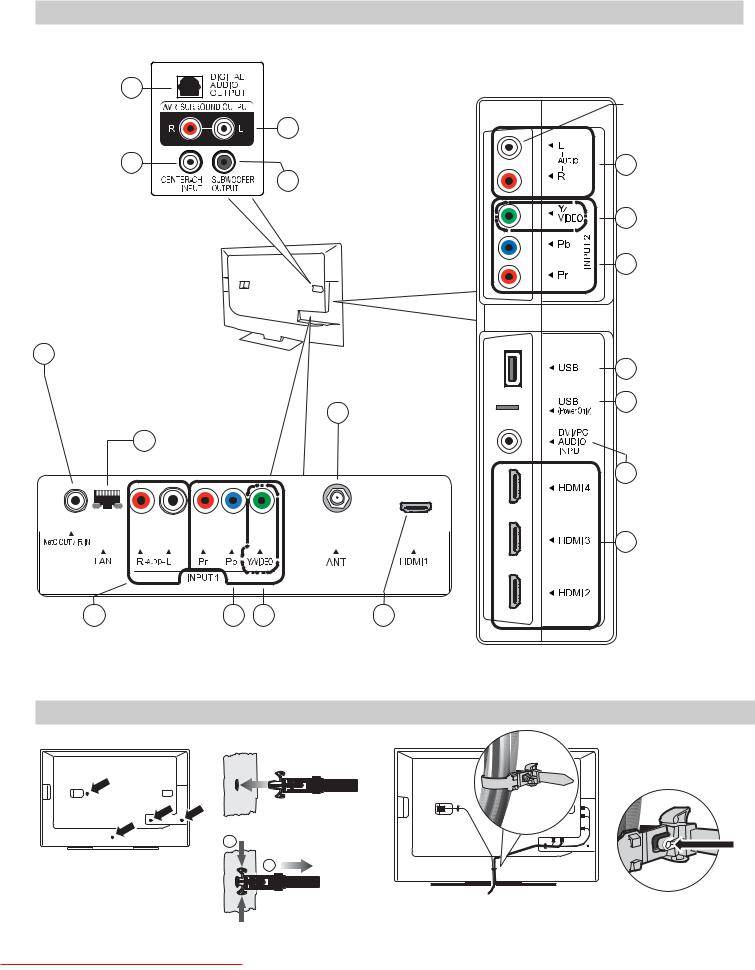
22 |
2. TV Connections |
Inputs and Outputs
DIGITAL |
11 |
|
|
Audio |
|
|
|
OUTPUT |
|
AVR/surround |
|
(page 27) |
12 |
||
|
|
OUTPUT |
|
CENTER-CH |
14 |
(page 27, page 41) |
|
|
|||
INPUT |
13 |
SUBWOOFER |
|
(page 28) |
|||
|
OUTPUT |
||
|
|
(page 28)
6NetC OUT/IR IN
(265 Series) NetCommand/ IR external controller jack.
See page 61) |
ANT |
|
|||||||||
|
|||||||||||
1 |
|
||||||||||
|
|
|
|
|
|
|
|
LAN |
coaxial antenna |
|
|
|
|
|
|
|
|
|
|
7 (Ethernet, port |
input |
|
|
|
|
|
|
|
|
|
|
(page 26) |
|
||
|
|
|
|
|
|
|
|
page 42) |
|
||
|
|
|
|
|
|
|
|
|
|
|
|
|
|
|
|
|
|
|
|
|
|
|
|
|
|
|
|
|
|
|
|
|
|
|
|
|
|
|
|
|
|
|
|
|
|
|
|
|
|
|
|
|
|
|
|
|
|
|
|
5 |
Y/VIDEO Pb Pr |
4 |
3 |
Y/VIDEO |
2 HDMI |
AUDIO |
component |
|
|
composite video |
(page 24) |
video input |
|
|
(page 26) |
||
analog stereo |
|
|
|
||
(page 25) |
|
|
|
|
|
audio input |
|
|
|
|
|
|
|
|
|
|
Calibration Microphone Input
(265 series, page 40)
5AUDIOanalog stereo audio input
3Y/VIDEO composite video input (page 26)
4Y/VIDEO Pb Pr component video input (page 25)
8USB (page 35) USB (Power Only)
9Provides power to TV accessories. (page 28)
10DVI/PC AUDIO INPUT
(page 25)
2HDMI
(page 24)
Cable Routing
Install the supplied cable ties in any of four mounting holes.
|
Press the release tab to |
|
loosen the cable bundle. |
Installing the cable |
|
tie |
|
1 |
|
2 |
|
Removing the |
Sample cable routing. Secure the cable |
cable tie |
bundle with the release tab facing out. |
DownloadedFor assistanceFrom TV-Manualcall.com 1(800)Manuals 332-2119

2. TV Connections |
23 |
Inputs and Outputs, continued
1. ANT (Antenna)
Connect your main antenna or direct cable service (without a cable box) to ANT. The ANT input can receive digital and analog over-the-air channels from a VHF/UHF antenna or non-scrambled digital/analog cable source.
2. HDMI® Inputs (High-Definition Multimedia Interface)
The HDMI inputs support uncompressed standard and high-definition digital video formats, bitstream Dolby Digital 5.1, and PCM digital stereo audio.
Mitsubishi recommends you use high-speed HDMI cables to connect newer source devices incorporating HDMI technology. High-speed cables bring you the full benefits of Deep Color and x.v.Color.
These HDMI inputs can also accept digital DVI video signals. To connect a device’s DVI output to the TV’s HDMI input, use an HDMI-to-DVI adapter or cable plus an analog audio. Connect the audio cable to the DVI/PC AUDIO INPUT jack on the TV to receive audio from your DVI device.
Use the HDMI inputs to connect to CEA-861 HDMI compliant devices such as a high-definition receiver or DVD player. These inputs support 480i, 480p, 720p, 1080i, and 1080p video formats.
The TV’s HDMI inputs are compatible with many DVI-D and HDMI computer video signals.
These inputs are HDCP (High-Bandwidth Digital Copy Protection) compliant.
HDMI Cable Categories
HDMI cables are available as Standard and High-Speed types.
•High-Speed HDMI Cables. Newer DVD players, video games, and set-top boxes require High-Speed HDMI cables, suitable for clock frequencies up to 340 MHz or data rates of up to 10.2 gigabits per second. Use high-speed cables for 1080p HD signals carrying extended color encodings (i.e., 30 or more bits, also called Deep Color). High-Speed HDMI cables are also suitable for standard HDTV signals.
•Standard HDMI Cables. Standard HDMI cables may be unmarked. They are suitable for standard HDTV 720p, 1080i, and 1080p signals with 8-bit color depth. Use Standard HDMI cables for clock frequencies up to 74.25 MHz or data rates of up to 2.23 gigabits per second.
3. Y/Video (Composite Video)
Use the adjacent AUDIO R and L inputs if you wish to send audio to the TV.
4. Y/VIDEO Pb Pr (Component Video)
Use the adjacent AUDIO R and L jacks if you wish to send audio to the TV.
5. AUDIO
Analog stereo inputs for use in conjunction with adjacent composite or component video jacks.
6. NetC Out/IR IN
265 Series
As an output: Connect IR emitters to this jack to send NetCommand control signals to external IR-controlled devices.
As an input: Accepts control signals from an external controller when set up by your professional installer.
7. LAN
Use the LAN Ethernet jack for streaming internet video to the TV. See page 42 for setup. Visit www.VUDU.com for details about VUDU™ service.
8. USB
The TV can read JPEG photo files and mp3 music files from a USB storage device connected to this input.
154 Series. Connect a compatible wireless adapter to stream internet content to the TV (page 42).
9. USB (Power Only)
Standard USB 5-volt, 500-milliamp power output you can use to supply power to an accessory device, such as a wireless subwoofer (page 28).
10. DVI/PC INPUT AUDIO
Connect a DVI device to one of the TV’s HDMI inputs and use this jack to send analog audio to the TV.
11. DIGITAL AUDIO OUTPUT
This output sends Dolby Digital or PCM digital audio to your digital A/V surround sound receiver. Incoming analog audio is converted by the TV to PCM digital audio. If you have a digital A/V receiver, in most cases this is the only audio connection needed between the TV and your A/V receiver.
Downloaded From TV-Manual.com Manuals
For assistance call 1(800) 332-2119
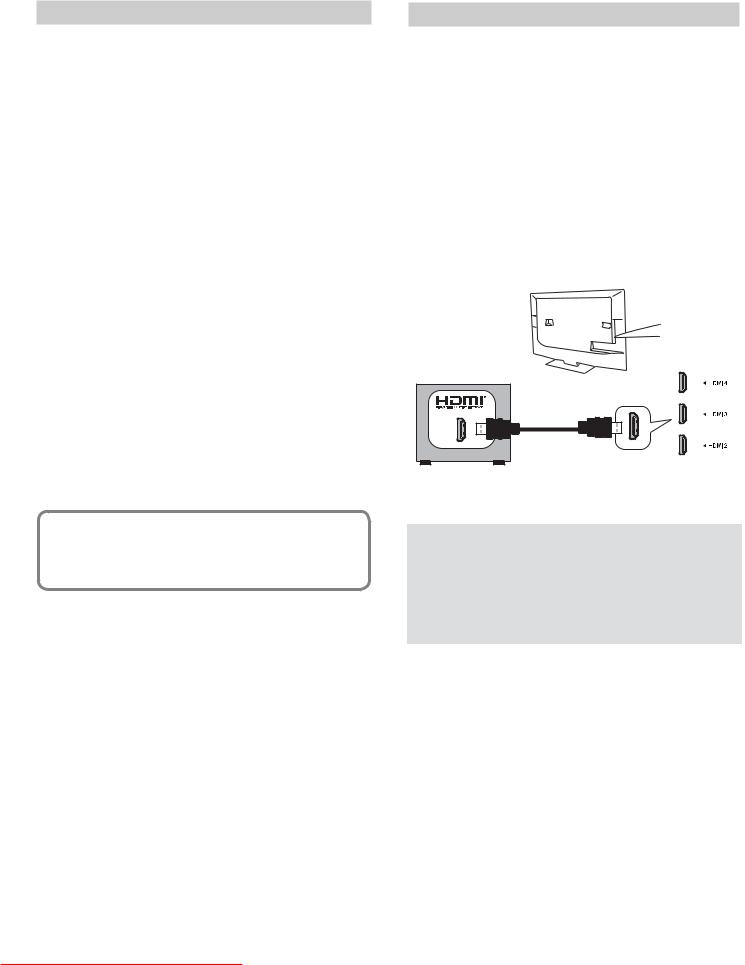
24 |
2. TV Connections |
Inputs and Outputs, continued
12.AVR/SURROUND OUTPUT
•Sends analog audio of the current program to an analog A/V surround sound receiver or stereo system. Digital audio from digital channels and HDMI devices is converted to analog audio by the TV for output on this jack. This is the only audio connection needed to the TV if using an analog A/V receiver or stereo system.
Note: If connecting headphones, set Sound > Global > Analog Audio Out to Variable.
•For a fuller surround sound effect, connect external rear speakers to this output to supplement the
TV’s speaker array. Set Sound > Global > Analog Audio Out to Rear.
HDMI Device
Commonly used with an HDTV Cable Box, Satellite Receiver, or DVD/Blu-ray Player
Required: HDMI-to-HDMI cable.
Connect an HDMI cable from the TV to the device’s HDMI output. HDMI-connectable devices provide video and audio through a single cable.
Mitsubishi recommends using high-speed HDMI cables to connect newer devices incorporating HDMI technology. See “HDMI Cable Categories” on the previous page for more on HDMI cable types.
Note: The HDMI connection supports copy protection (HDCP).
13. SUBWOOFER OUTPUT
Connect a powered subwoofer to this input to complement effects from the TV’s speaker array. Set Sound > Global > Subwoofer to On to enable this output.
14. CENTER CH INPUT
Connect your A/V receiver’s center channel output to this input to make the TV speakers output center-chan- nel sound. Set Sound > Global > Center Channel
to On to enable this input. See Sound > Audio > TV Speakers > Center page 49.
Auto Input Sensing
The TV’s Auto Input Sensing feature automatically recognizes some connections and prompts you to identify the device type. See page 15.
HDMI-to-HDMI |
cable |
Any HDMI device |
TV |
|
IMPORTANT
HDMI and Digital Surround Sound
Use an HDMI connection if you want to hear digital surround sound from the TV’s internal speaker array. The TV’s HDMI inputs can receive digital surround sound from an HDMI device.
DownloadedFor assistanceFrom TV-Manualcall.com 1(800)Manuals 332-2119
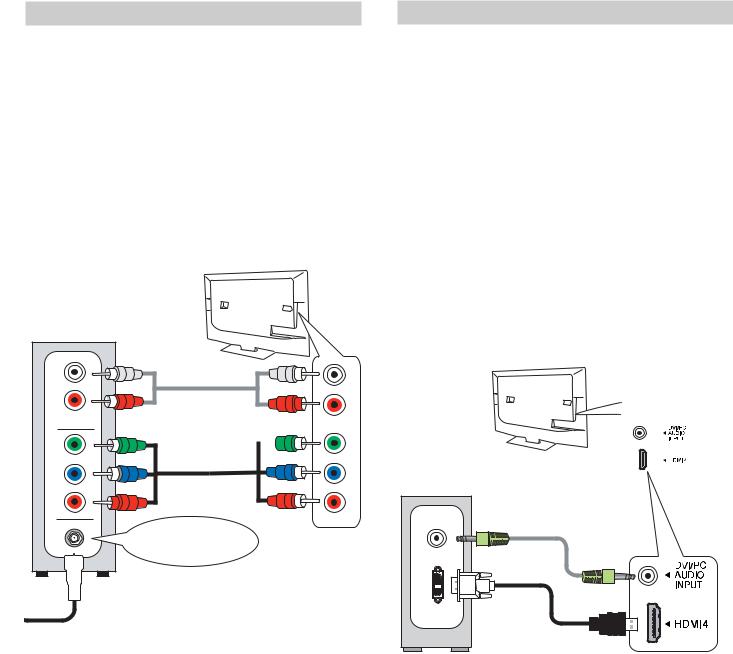
2. TV Connections |
25 |
Y Pb Pr Component Video Device
Commonly used with an HDTV Cable Box, Satellite Receiver, or DVD/Blu-ray Player
If your source device has an HDMI output, use the connections for HDMI devices described on the opposite page instead of component video.
Required:
RCA-type component video cables Left/right analog audio cables.
Note: To hear digital surround sound from an A/V receiver, connect the digital audio output from the device directly to your digital A/V receiver.
Component video device
Audio |
cables |
AUDIO
Component  video cables
video cables
CABLE IN or |
TV |
|
SATELLITE IN |
||
|
DVI Video Device
Commonly used with a Cable Box, Satellite Receiver, or DVD Player
Connect a DVI device (digital only) to one of the TV’s HDMI input jacks.
Required:
Analog stereo audio cables
DVI-to-HDMI cable or DVI/HDMI adapter and HDMI cable
If you are using a DVI/HDMI adapter, it is important to connect the adapter to the DVI device for best performance.
Some devices require connection to an analog input first in order to view on-screen menus and to select DVI as the ouput. Please review your equipment instructions for DVI connectivity and compatibility.
Note: The HDMI connection supports copy protection (HDCP).
Digital DVI
device
AUDIO |
TV |
OUT |
|
|
Audio cable |
DVI OUT |
|
|
DVI-to-HDMI |
|
cable |
Downloaded From TV-Manual.com Manuals
For assistance call 1(800) 332-2119
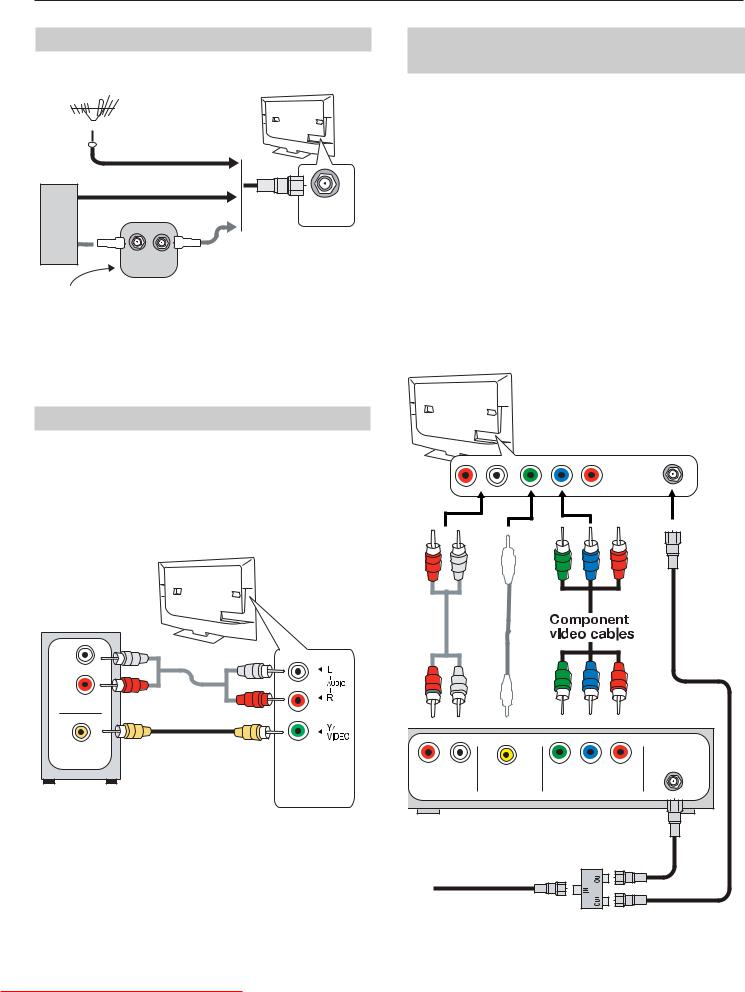
26 |
2. TV Connections |
Antenna or Cable TV Service
Connect the incoming cable to the TV’s ANT input.
Antenna 
|
or |
|
Direct cable (no cable box) |
|
|
TV |
or |
ANT |
service |
|
|
|
|
|
Cable |
|
|
IN |
OUT Older cable |
|
|
box |
|
Not recommeded. Other connection types provide better quality audio and video.
VCR or DVD Recorder to an
Antenna or Wall Outlet Cable
Required:
1.Video cables
1a. Component video cables (red/blue/green) or
1b. Composite video cable (usually yellow)
2.Left/right analog audio cables.
3.Two-way RF splitter
4.Two coaxial cables
Note:
•Use composite video only if component video or HDMI are unavailable.
•If your recording device has an analog-only tuner, you must use a digital converter box to enable recording of digital broadcasts.
Composite Video Device
VCR or other device with composite video output
Required:
Composite video cable (usually yellow) Analog stereo audio cables.
TV
L |
|
|
R |
Audio |
|
AUDIO OUT |
||
cables |
||
|
COMPOSITE |
Composite |
VIDEO OUT |
video cable |
VCR or other device with composite video output
DownloadedFor assistanceFrom TV-Manualcall.com 1(800)Manuals 332-2119
|
|
or |
|
|
Composite cablevideo |
1b. |
1a. |
2. |
|
|
|
|
|
|
|
|
|
|
ANTENNA |
R |
L |
COMPOSITE |
COMPONENT |
IN |
|
||||
AUDIO OUT |
VIDEO OUT |
VIDEO OUT |
|
|
DVD Recorder or VCR |
|
|||
|
|
|
3. |
4. |
|
|
|
RF Splitter |
|
|
Incoming cable |
|
||
|
|
4. |
||
|
|
|
|
|
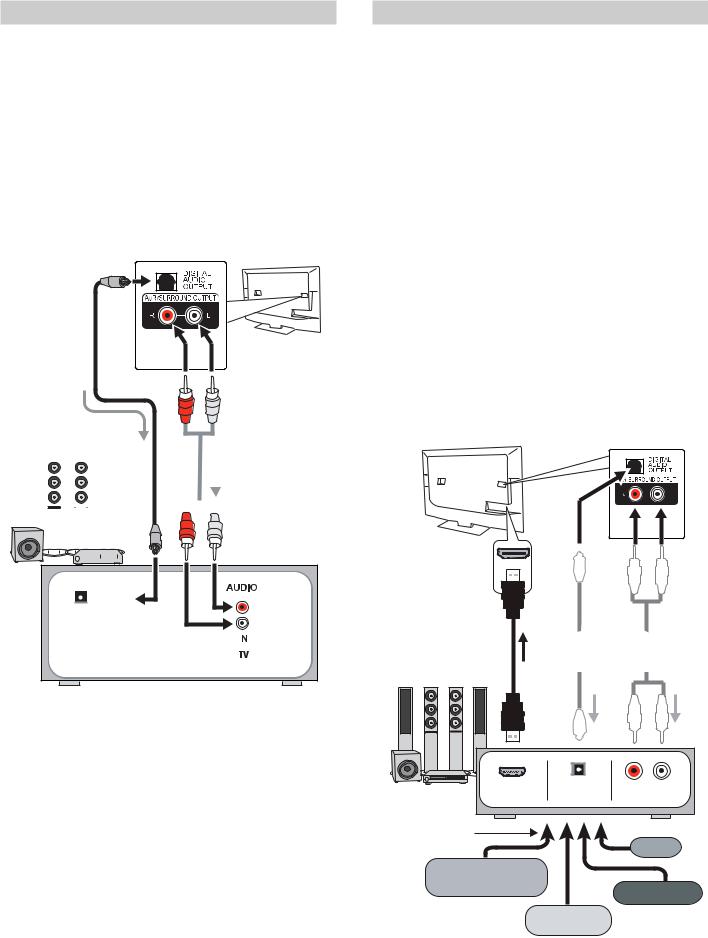
2. TV Connections |
27 |
A/V Receiver
Most setups require either a digital audio cable or analog stereo audio cables. To send audio from TV channels received on the ANT input or devices connected directly to the TV, you must use one of the connections shown below.
The TV makes all audio available in digital and analog formats:
•Analog audio coming into the TV is available as output in digital stereo format on the DIGITAL AUDIO OUTPUT jack.
•Digital incoming audio is available as analog output on the AVR/SURROUND OUTPUT L and R jacks.
Optical cable (digital A/V receiver)
|
|
|
|
|
|
|
|
|
|
|
|
or |
Stereo analog cables |
|
|
|
|
|
|
|
|
|
|
|
|
|
(analog A/V receiver) |
||
|
|
|
|
|
|
|
|
|
|
|||||
|
|
|
|
|
|
|
|
|
|
|
|
|
|
|
|
|
|
|
|
|
|
|
|
|
|
|
|
|
|
|
|
|
|
|
|
|
|
|
|
|
|
|
|
|
|
|
|
|
|
|
|
|
|
|
|
|
|
|
|
|
|
|
|
|
|
|
|
|
|
|
|
|
|
|
|
|
|
|
|
|
|
|
|
|
|
|
|
|
|
OPTICAL |
INPUT |
A/V receiver back panel
Note:
•On rare occasions, an HDMI signal may be copy-restricted and cannot be output from the TV as a digital signal. To hear these copy-
protected signals through the A/V receiver, use the connection for an analog A/V receiver.
•Check the A/V receiver’s Owner’s Guide for information concerning use of the digital input and switching between digital sound and analog stereo sound from the TV.
Downloaded From TV-Manual.com Manuals
A/V Receiver with HDMI Output
Required: One HDMI-to-HDMI cable
This option allows you to view content from devices connected to an A/V receiver. The A/V receiver can send audio and video to the TV over a single HDMI cable. You can use an HDMI connection as described here in addition to an audio connection from the TV’s audio output. The optional audio connection allows you to hear, through the A/V receiver, devices connected to the TV only, e.g., an antenna on the ANT input.
•You may be able to use the TV’s remote control (in TV mode) to operate connected CEC-enabled HDMI devices. Experiment with your equipment to determine which functions are available to the TV’s remote control. See Appendix C, page 81.
•265 Series: This setup allows you to use NetCom- mand-controlled audio and video switching over the HDMI cable. See “Automatic Audio/Video Switching Over an HDMI Connection” on page 69.
•265 Series: To use NetCommand to supplement HDMI control of a CEC-enabled A/V receiver, note the recommendations under “More About Using an HDMI Connection,” page 69.
TV
Optional analog or
HDMI cable digital audio connection
A/V receiver with |
HDMI OUT |
OPTICAL |
R |
L |
|
AUDIO IN |
ANALOG AUDIO IN |
||
HDMI output |
|
|
|
|
Any connection |
VCR |
types |
|
High-definition |
|
DVD player |
DVD player |
|
|
|
Cable box |
For assistance call 1(800) 332-2119
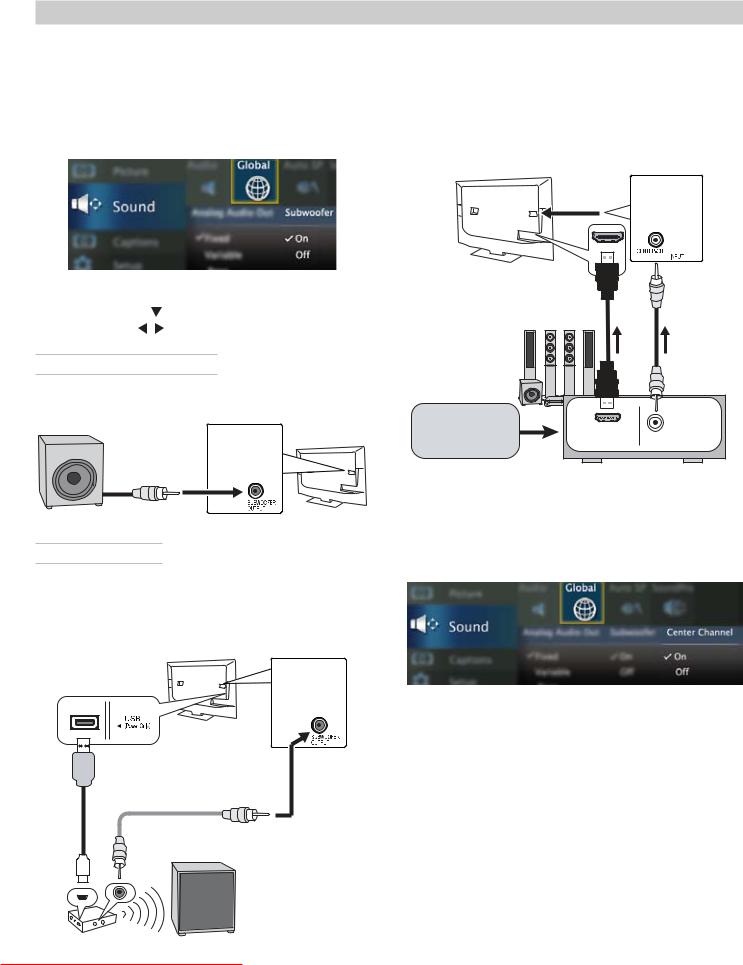
28 |
2. TV Connections |
Supplemental Audio Connections
Adding a Subwoofer
Add a subwoofer to complement the TV speakers with a fuller bass sound.
•After connecting a subwoofer, you must enable the TV’s subwoofer output in the TV’s Sound menu. Go to Sound > Global > Subwoofer and set it to On.
Using the TV Speakers as a Center Channel
If using an external surround sound system, you can make the TV’s speakers provide center channel sound. Your A/V receiver must have a center channel pre out that can supply an amplified center-channel signal to the TV.
1.Connect your A/V receiver’s HDMI output and center channel pre out to the TV as shown.
•To control subwoofer volume, press the AUDIO key
and then press |
to find the subwoofer volume |
slider. Press |
to change the volume. |
Subwoofer with Audio Cable
Connect the subwoofer directly to the TV’s SUBWOOFER OUTPUT.
Wireless Subwoofer
Mitsubishi recommends Polk Audio Wireless Subwoofer model PSW i8m. The transmitter module can be conveniently powered from the TV’s USB power port. Connect an audio cable to the transmitter to supply audio from the TV’s SUBWOOFER OUTPUT.
Power-only
USB port
USB/USB
mini-plug
power cable RCA/RCA audio cable
Polk Audio PSW i8m powered wireless subwoofer
DownloadedFor assistanceFrom TV-Manualcall.com 1(800)Manuals 332-2119
HDMI cable |
RCA/RCA |
audio cable |
A/V receiver with HDMI
output |
|
|
|
|
CENTER |
Surround sound |
HDMI OUT |
CHANNEL |
source device |
PRE OUT |
|
|
|
2.Turn on the A/V receiver’s center channel pre out if needed. See the A/V receiver’s instruction manual.
3.Press the VOL key to adjust TV volume to about level 30.
4.Enable the TV’s center channel mode:
a.Go to Sound > Global and set Center Channel to On.
b.Press the AUDIO key and press to display the TV Speakers option. Press
to display the TV Speakers option. Press  to select Center.
to select Center.
5.To balance volume:
a.Power on the A/V receiver and TV.
b.Compare the volume of the TV’s center channel with the rest of the sound system. If the TV volume needs adjustment,
i.Turn on the TV speakers. Press AUDIO and
press to display the TV Speakers option. Press
to display the TV Speakers option. Press  to select On.
to select On.
ii.Adjust TV volume using the VOL key.
iii.Return the TV to center channel mode. Press
AUDIO and press to display the TV Speakers option. Press
to display the TV Speakers option. Press  to select Center.
to select Center.
iv.Compare the sound volume. Repeat this adjustment if needed.
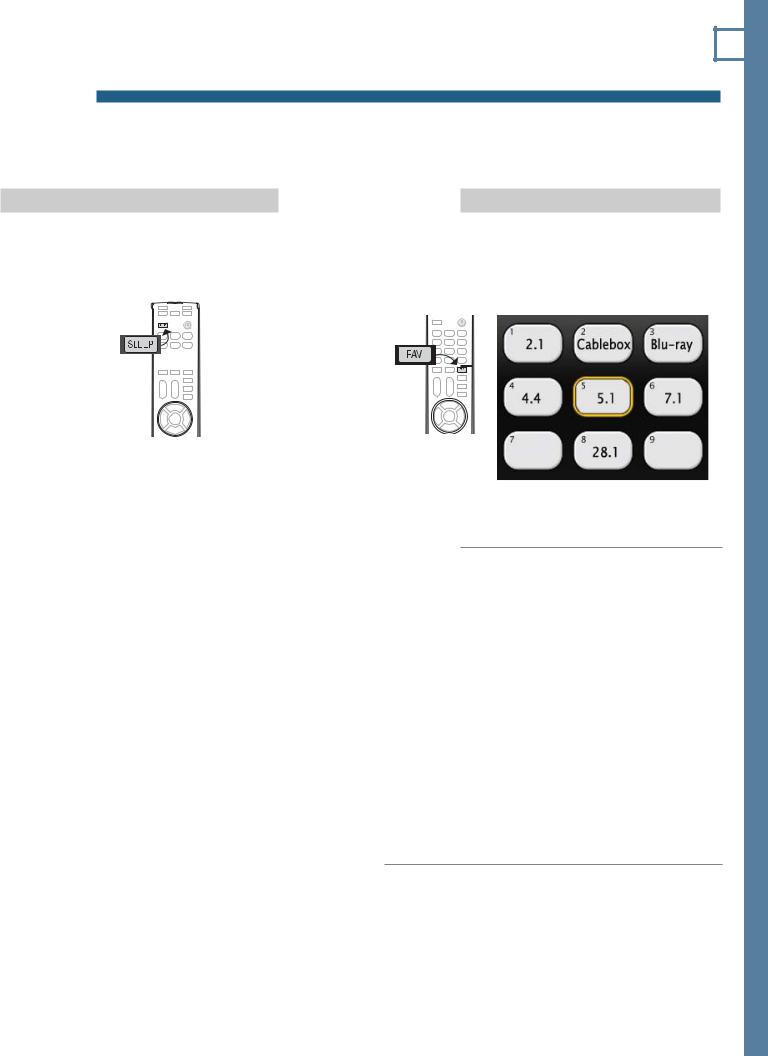
3 TV Features
Sleep Timer
The Sleep Timer turns the TV off after the length of time you set. To set the TV to turn on at a certain time of day, see the Setup > Timer menu on page 52.
Setting the Sleep Timer
1.Press SLEEP.
2.Press SLEEP additional times to increase the time in 30-minute increments up to the maximum of 120 minutes.
3.Press EXIT to clear the screen immediately. Otherwise the screen will clear after five seconds of inactivity.
Viewing or Changing the Sleep Timer
1.Press SLEEP to display the on-screen message.
2.Press SLEEP additional times to change the time before the TV powers off. To cancel the Sleep Timer, press SLEEP repeatedly until OFF is displayed.
29 |
FAV (Favorite Channels)
The FAV key gives you quick access to favorite program sources. Sources can be channels from the ANT input or devices connected to the TV. You can store up to nine favorites.
Sample Favorites menu. Switch to favorite channels or inputs using number keys.
|
1. |
Press INPUT and switch the TV to the input |
||
|
|
you want to add. If adding a channel, switch |
||
Adding |
|
to the ANT input and tune to the channel. |
||
3. Move the highlight to the number position |
||||
|
2. |
Press the FAV key. |
||
|
|
you want to assign to the channel or input. |
||
|
4. |
Press ENTER. |
||
|
|
|
|
|
Removing |
1. |
While watching TV, press the FAV key. |
||
2. |
In the Favorites menu, highlight the channel |
|||
|
||||
|
|
or input you want to remove. |
||
|
3. |
Press CANCEL. |
||
|
|
|
|
|
Selecting |
1. |
While watching TV, press the FAV key. |
||
2. |
Move the highlight to the item you want and |
|||
|
||||
press ENTER. For a shortcut, just press the number key for the channel or input.
Downloaded From TV-Manual.com Manuals
For assistance call 1(800) 332-2119
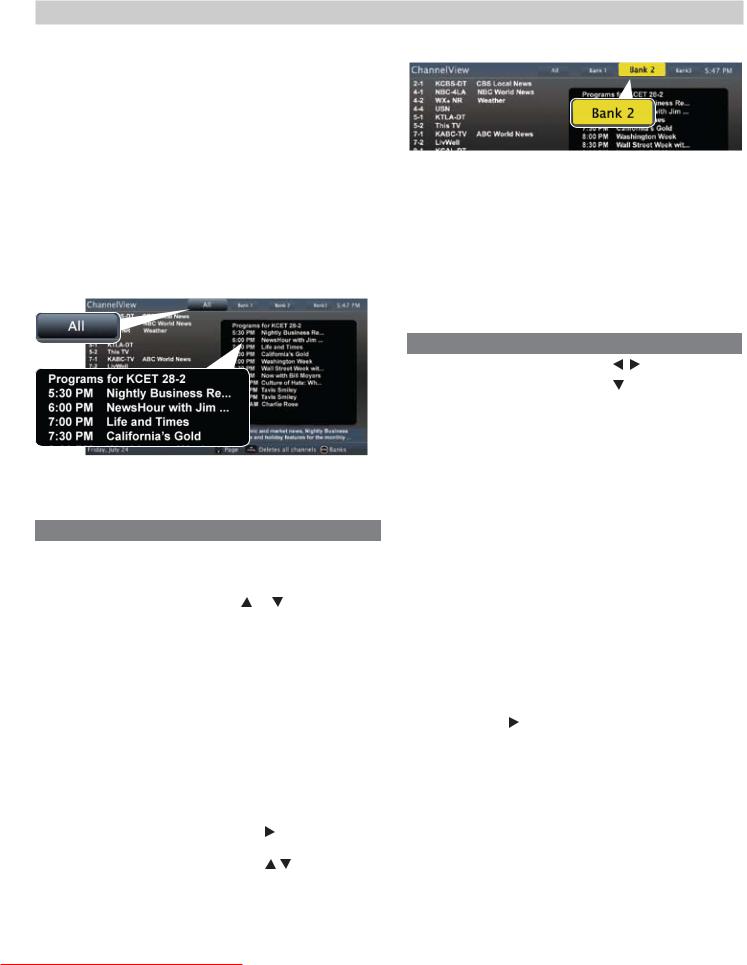
30 |
3. TV Features |
ChannelView Channel Listings
ChannelView displays program descriptions sent by broadcasters. This information may be unavailable in some areas.
About ChannelView
ChannelView™ shows memorized channels on the ANT input. It displays channel names and program information for digital channels. No program information is displayed for analog channels.
ChannelView allows you to set up three banks of custom channels for convenient access. You can save groups of channels by content (e.g., news, sports, children’s programming) or by TV user.
Note: You must first set the TV Clock (page 52) to receive ChannelView listings.
ChannelView, “All” tab. Programs are listed on the right.
Using ChannelView Listings
Task |
Action |
|
|
Display/hide |
Press GUIDE. |
|
|
ChannelView listings |
|
|
|
(ANT input only). |
|
|
|
|
|
||
Move through channels |
Press or . |
||
one by one. |
|
|
|
|
|
|
|
Move through channels |
Press CH. |
|
|
quickly. |
|
|
|
|
|
||
Jump to listings for a |
Enter the channel number. |
||
specific channel. |
Press CANCEL to add a dash; |
||
|
press twice to clear the |
||
|
channel number. |
||
|
|
|
|
Tune to a highlighted |
Press ENTER. |
|
|
channel. |
|
|
|
|
|
||
Update program infor- |
Press the INFO key (the |
||
mation for a highlighted |
screen may briefly go |
||
digital channel. |
blank). |
|
|
|
|
|
|
Display program descrip- |
1. |
Press |
to move into |
tions, if available. The |
|
the program area. |
|
description will appear at |
2. |
Press |
to move |
the bottom of the screen. |
|
between programs. |
|
|
|
|
|
Display more program |
Press INFO. |
|
|
description for the current |
|
|
|
channel (if available). |
|
|
|
|
|
|
|
DownloadedFor assistanceFrom TV-Manualcall.com 1(800)Manuals 332-2119
ChannelView Custom Channel Banks
Select a channel bank to customize.
1.Press GUIDE to display ChannelView.
2.Press MENU to move the highlight to the bank header.
3.Press to select Bank 1, 2, or 3.
to select Bank 1, 2, or 3.
4.With the bank name highlighted, press ENTER to enter setup mode where you can select channels to include in the bank.
5.Press EXIT when finished with setup.
Task |
Action |
|
Move between banks |
Press |
. |
|
|
|
Move into the channel list |
Press . |
|
|
|
|
Add or delete a channel |
• Highlight the channel |
|
from the bank |
and press ENTER. A |
|
|
check indicates the |
|
|
channel has been |
|
|
added. |
|
|
• Press ENTER again to |
|
|
clear the check and |
|
|
remove the channel. |
|
|
|
|
Remove all channels |
Press CANCEL. |
|
from the selected bank |
|
|
|
|
|
Enter or exit setup mode |
Press MENU. |
|
|
|
|
Using Custom Channel Banks
•While watching TV, press CH. The TV will tune only to channels stored in the current bank.
•To change to a different channel bank:
1.Press GUIDE.
2.Press MENU.
3.Press .
.
4.Press EXIT.
•To allow tuning to any channel in memory, select the All bank.
